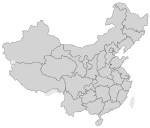China
China (Chinese: 中国; lit.: 'Central State; Middle Kingdom'), officially the People's Republic of China (PRC) (Chinese: 中华人民共和国), is a country in East Asia. It is the world's most populous country, with a population of around 1.4 billion in 2019.[7] Covering approximately 9.6 million square kilometres (3.7 million mi2), it is the world's third or fourth-largest country by area.[lower-alpha 11] Governed solely by the Chinese Communist Party (CCP), the state exercises jurisdiction over 22 provinces,[lower-alpha 12] five autonomous regions, four direct-controlled municipalities (Beijing, Tianjin, Shanghai, and Chongqing), and the special administrative regions of Hong Kong and Macau.
People's Republic of China | |
|---|---|
.svg.png) National Emblem
| |
 Land controlled by the People's Republic of China shown in dark green; land claimed but not controlled shown in light green. | |
| Capital | Beijing 39°55′N 116°23′E |
| Largest city | Shanghai (urban area) Chongqing (city proper)[lower-alpha 1] |
| Official languages | Standard Chinese[lower-alpha 2] |
| Recognised regional languages | |
| Official script | Simplified Chinese[lower-alpha 3] |
| Ethnic groups |
|
| Religion | See Religion in China |
| Demonym(s) | Chinese |
| Government | Unitary Marxist-Leninist[1] one-party socialist republic[2] |
| Xi Jinping[lower-alpha 5] | |
• Premier | Li Keqiang |
| Li Zhanshu | |
• Conference Chairman | Wang Yang |
• First Secretary of the Party Secretariat | Wang Huning |
| Zhao Leji | |
• First Vice Premier | Han Zheng |
| Wang Qishan[lower-alpha 6] | |
| Legislature | National People's Congress |
| Formation | |
| c. 2070 BCE | |
| 221 BCE | |
• Republic established | 1 January 1912 |
| 1 October 1949 | |
• Current constitution | 4 December 1982 |
| 20 December 1999 | |
| Area | |
• Total | 9,596,961 km2 (3,705,407 sq mi)[lower-alpha 7][5] (3rd/4th) |
• Water (%) | 2.8%[lower-alpha 8] |
| Population | |
• 2019 estimate | |
• 2010 census | 1,340,910,000[7] (1st) |
• Density | 145[8]/km2 (375.5/sq mi) (83rd) |
| GDP (PPP) | 2020 estimate |
• Total | |
• Per capita | |
| GDP (nominal) | 2020 estimate |
• Total | |
• Per capita | |
| Gini (2018) | high |
| HDI (2018) | high · 85th |
| Currency | Renminbi (yuan; ¥)[lower-alpha 9] (CNY) |
| Time zone | UTC+8 (China Standard Time) |
| Date format | |
| Driving side | right[lower-alpha 10] |
| Calling code | +86 |
| ISO 3166 code | CN |
| Internet TLD | |
China emerged as one of the world's first civilizations, in the fertile basin of the Yellow River in the North China Plain. For millennia, China's political system was based on absolute and hereditary monarchies, or dynasties, beginning with the semi-mythical Xia dynasty in 21st century BCE. Since then, China has expanded, fractured, and re-unified numerous times. In the 3rd century BCE, the Qin reunited core China and established the first Chinese empire. The succeeding Han dynasty, which ruled from 206 BCE until 220 CE, saw some of the most advanced technology at that time, including papermaking and the compass, along with agricultural and medical improvements. The invention of gunpowder and movable type in the Tang dynasty (618–907) and Northern Song (960–1127) completed the Four Great Inventions. Tang culture spread widely in Asia, as the new Silk Route brought traders to as far as Mesopotamia and the Horn of Africa. Dynastic rule ended in 1912 with the Xinhai Revolution, when the Republic of China (ROC) replaced the Qing dynasty. China was invaded by Imperial Japan during World War II. The Chinese Civil War resulted in a division of territory in 1949, when the CCP led by Mao Zedong established the People's Republic of China on mainland China while the Kuomintang-led nationalist government retreated to the island of Taiwan, where it governed until 1996 when Taiwan transitioned to democracy.
China is a unitary one-party socialist republic, and is one of the few still existing nominally socialist states. Political dissidents and human rights groups have denounced and criticized the Chinese government for human rights abuses, including suppression of religious and ethnic minorities in Xinjiang and Tibet, censorship, mass surveillance, and their response to protests such as the 1989 Tiananmen Square protests. In Xinjiang, the Chinese Government has detained Uyghurs in Vocational Education and Training Centers, which critics call internment camps.[12][13][14] The Chinese government denies these statements and says its response helps combat terrorism in the province.[15][16]
Since the introduction of economic reforms in 1978, China's economy has been one of the world's fastest-growing, with annual growth rates consistently above 6 percent. According to the World Bank, China's GDP grew from $150 billion in 1978 to $12.24 trillion by 2017. Since 2010, China has been the world's second-largest economy by nominal GDP, and since 2014, the largest economy in the world by PPP. China is also the world's largest exporter and second-largest importer of goods. China is a recognized nuclear weapons state and has the world's largest standing army, the People's Liberation Army, and the second-largest defense budget. The PRC is a permanent member of the United Nations Security Council since replacing the ROC in 1971. China has been characterized as an emerging superpower, mainly because of its accelerating infrastructural development, large and rapidly-growing economy, and powerful military.
Names
| China | |||||||||||||||||||||||||||||||||||||||||||||||||||||||||||||||||||||||||
|---|---|---|---|---|---|---|---|---|---|---|---|---|---|---|---|---|---|---|---|---|---|---|---|---|---|---|---|---|---|---|---|---|---|---|---|---|---|---|---|---|---|---|---|---|---|---|---|---|---|---|---|---|---|---|---|---|---|---|---|---|---|---|---|---|---|---|---|---|---|---|---|---|---|
.svg.png) "China" in Simplified (top) and Traditional (bottom) Chinese characters | |||||||||||||||||||||||||||||||||||||||||||||||||||||||||||||||||||||||||
| Chinese name | |||||||||||||||||||||||||||||||||||||||||||||||||||||||||||||||||||||||||
| Simplified Chinese | 中国 | ||||||||||||||||||||||||||||||||||||||||||||||||||||||||||||||||||||||||
| Traditional Chinese | 中國 | ||||||||||||||||||||||||||||||||||||||||||||||||||||||||||||||||||||||||
| Hanyu Pinyin | Zhōngguó | ||||||||||||||||||||||||||||||||||||||||||||||||||||||||||||||||||||||||
| Literal meaning | "Middle" or "Central State"[17] | ||||||||||||||||||||||||||||||||||||||||||||||||||||||||||||||||||||||||
| |||||||||||||||||||||||||||||||||||||||||||||||||||||||||||||||||||||||||
| Alternate name | |||||||||||||||||||||||||||||||||||||||||||||||||||||||||||||||||||||||||
| Simplified Chinese | 中华 | ||||||||||||||||||||||||||||||||||||||||||||||||||||||||||||||||||||||||
| Traditional Chinese | 中華 | ||||||||||||||||||||||||||||||||||||||||||||||||||||||||||||||||||||||||
| Hanyu Pinyin | Zhōnghuá | ||||||||||||||||||||||||||||||||||||||||||||||||||||||||||||||||||||||||
| |||||||||||||||||||||||||||||||||||||||||||||||||||||||||||||||||||||||||
| Tibetan name | |||||||||||||||||||||||||||||||||||||||||||||||||||||||||||||||||||||||||
| Tibetan | ཀྲུང་གོ་ | ||||||||||||||||||||||||||||||||||||||||||||||||||||||||||||||||||||||||
| |||||||||||||||||||||||||||||||||||||||||||||||||||||||||||||||||||||||||
| Zhuang name | |||||||||||||||||||||||||||||||||||||||||||||||||||||||||||||||||||||||||
| Zhuang | Cungguek | ||||||||||||||||||||||||||||||||||||||||||||||||||||||||||||||||||||||||
| Mongolian name | |||||||||||||||||||||||||||||||||||||||||||||||||||||||||||||||||||||||||
| Mongolian script | |||||||||||||||||||||||||||||||||||||||||||||||||||||||||||||||||||||||||
| |||||||||||||||||||||||||||||||||||||||||||||||||||||||||||||||||||||||||
| Uyghur name | |||||||||||||||||||||||||||||||||||||||||||||||||||||||||||||||||||||||||
| Uyghur | جۇڭگو | ||||||||||||||||||||||||||||||||||||||||||||||||||||||||||||||||||||||||
| |||||||||||||||||||||||||||||||||||||||||||||||||||||||||||||||||||||||||
| Manchu name | |||||||||||||||||||||||||||||||||||||||||||||||||||||||||||||||||||||||||
| Manchu script | |||||||||||||||||||||||||||||||||||||||||||||||||||||||||||||||||||||||||
| Romanization | Dulimbai Gurun | ||||||||||||||||||||||||||||||||||||||||||||||||||||||||||||||||||||||||
The word "China" has been used in English since the 16th century; however, it was not a word used by the Chinese themselves during this period in time. Its origin has been traced through Portuguese, Malay, and Persian back to the Sanskrit word Cīna, used in ancient India.[18]
"China" appears in Richard Eden's 1555 translation[lower-alpha 13] of the 1516 journal of the Portuguese explorer Duarte Barbosa.[lower-alpha 14][18] Barbosa's usage was derived from Persian Chīn (چین), which was in turn derived from Sanskrit Cīna (चीन).[23] Cīna was first used in early Hindu scripture, including the Mahābhārata (5th century BCE) and the Laws of Manu (2nd century BCE).[24] In 1655, Martino Martini suggested that the word China is derived ultimately from the name of the Qin dynasty (221–206 BCE).[25][24] Although this derivation is still given in various sources,[26] the origin of the Sanskrit word is a matter of debate, according to the Oxford English Dictionary.[18] Alternative suggestions include the names for Yelang and the Jing or Chu state.[24][27]
The official name of the modern state is the "People's Republic of China" (simplified Chinese: 中华人民共和国; traditional Chinese: 中華人民共和國; pinyin: Zhōnghuá Rénmín Gònghéguó). The shorter form is "China" Zhōngguó (中国; 中國) from zhōng ("central") and guó ("state"),[lower-alpha 15] a term which developed under the Western Zhou dynasty in reference to its royal demesne.[lower-alpha 16] It was then applied to the area around Luoyi (present-day Luoyang) during the Eastern Zhou and then to China's Central Plain before being used as an occasional synonym for the state under the Qing.[29] It was often used as a cultural concept to distinguish the Huaxia people from perceived "barbarians".[29] The name Zhongguo is also translated as "Middle Kingdom" in English.[31]
History
Prehistory
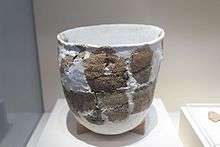
Archaeological evidence suggests that early hominids inhabited China between 2.24 million and 250,000 years ago.[32] The hominid fossils of Peking Man, a Homo erectus who used fire,[33] were discovered in a cave at Zhoukoudian near Beijing; they have been dated to between 680,000 and 780,000 years ago.[34] The fossilized teeth of Homo sapiens (dated to 125,000–80,000 years ago) have been discovered in Fuyan Cave in Dao County, Hunan.[35] Chinese proto-writing existed in Jiahu around 7000 BCE,[36] Damaidi around 6000 BCE,[37] Dadiwan from 5800–5400 BCE, and Banpo dating from the 5th millennium BCE. Some scholars have suggested that the Jiahu symbols (7th millennium BCE) constituted the earliest Chinese writing system.[36]
Early dynastic rule
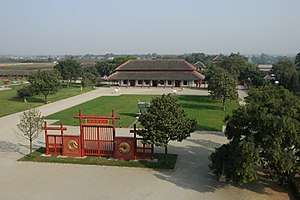
According to Chinese tradition, the first dynasty was the Xia, which emerged around 2100 BCE.[38] Xia dynasty marked the beginning of China's political system based on hereditary monarchies, or dynasties, which lasted for a millennium.[39] The dynasty was considered mythical by historians until scientific excavations found early Bronze Age sites at Erlitou, Henan in 1959.[40] It remains unclear whether these sites are the remains of the Xia dynasty or of another culture from the same period.[41] The succeeding Shang dynasty is the earliest to be confirmed by contemporary records.[42] The Shang ruled the plain of the Yellow River in eastern China from the 17th to the 11th century BCE.[43] Their oracle bone script (from c. 1500 BCE)[44][45] represents the oldest form of Chinese writing yet found,[46] and is a direct ancestor of modern Chinese characters.[47]
The Shang was conquered by the Zhou, who ruled between the 11th and 5th centuries BCE, though centralized authority was slowly eroded by feudal warlords. Some principalities eventually emerged from the weakened Zhou, no longer fully obeyed the Zhou king and continually waged war with each other in the 300-year Spring and Autumn period. By the time of the Warring States period of the 5th–3rd centuries BCE, there were only seven powerful states left.
Imperial China
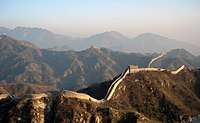
The Warring States period ended in 221 BCE after the state of Qin conquered the other six kingdoms, reunited China and established the dominant order of autocracy. King Zheng of Qin proclaimed himself the First Emperor of the Qin dynasty. He enacted Qin's legalist reforms throughout China, notably the forced standardization of Chinese characters, measurements, road widths (i.e., cart axles' length), and currency. His dynasty also conquered the Yue tribes in Guangxi, Guangdong, and Vietnam.[48] The Qin dynasty lasted only fifteen years, falling soon after the First Emperor's death, as his harsh authoritarian policies led to widespread rebellion.[49][50]
Following a widespread civil war during which the imperial library at Xianyang was burned,[lower-alpha 17] the Han dynasty emerged to rule China between 206 BCE and CE 220, creating a cultural identity among its populace still remembered in the ethnonym of the Han Chinese.[49][50] The Han expanded the empire's territory considerably, with military campaigns reaching Central Asia, Mongolia, South Korea, and Yunnan, and the recovery of Guangdong and northern Vietnam from Nanyue. Han involvement in Central Asia and Sogdia helped establish the land route of the Silk Road, replacing the earlier path over the Himalayas to India. Han China gradually became the largest economy of the ancient world.[52] Despite the Han's initial decentralization and the official abandonment of the Qin philosophy of Legalism in favor of Confucianism, Qin's legalist institutions and policies continued to be employed by the Han government and its successors.[53]
After the end of the Han dynasty, a period of strife known as Three Kingdoms followed,[54] whose central figures were later immortalized in one of the Four Classics of Chinese literature. At its end, Wei was swiftly overthrown by the Jin dynasty. The Jin fell to civil war upon the ascension of a developmentally-disabled emperor; the Five Barbarians then invaded and ruled northern China as the Sixteen States. The Xianbei unified them as the Northern Wei, whose Emperor Xiaowen reversed his predecessors' apartheid policies and enforced a drastic sinification on his subjects, largely integrating them into Chinese culture. In the south, the general Liu Yu secured the abdication of the Jin in favor of the Liu Song. The various successors of these states became known as the Northern and Southern dynasties, with the two areas finally reunited by the Sui in 581. The Sui restored the Han to power through China, reformed its agriculture, economy and imperial examination system, constructed the Grand Canal, and patronized Buddhism. However, they fell quickly when their conscription for public works and a failed war in northern Korea provoked widespread unrest.[55][56]
Under the succeeding Tang and Song dynasties, Chinese economy, technology, and culture entered a golden age.[57] The Tang Empire retained control of the Western Regions and the Silk Road,[58] which brought traders to as far as Mesopotamia and the Horn of Africa,[59] and made the capital Chang'an a cosmopolitan urban center. However, it was devastated and weakened by the An Lushan Rebellion in the 8th century.[60] In 907, the Tang disintegrated completely when the local military governors became ungovernable. The Song dynasty ended the separatist situation in 960, leading to a balance of power between the Song and Khitan Liao. The Song was the first government in world history to issue paper money and the first Chinese polity to establish a permanent standing navy which was supported by the developed shipbuilding industry along with the sea trade.[61]
.jpg)
Between the 10th and 11th centuries, the population of China doubled in size to around 100 million people, mostly because of the expansion of rice cultivation in central and southern China, and the production of abundant food surpluses. The Song dynasty also saw a revival of Confucianism, in response to the growth of Buddhism during the Tang,[62] and a flourishing of philosophy and the arts, as landscape art and porcelain were brought to new levels of maturity and complexity.[63][64] However, the military weakness of the Song army was observed by the Jurchen Jin dynasty. In 1127, Emperor Huizong of Song and the capital Bianjing were captured during the Jin–Song Wars. The remnants of the Song retreated to southern China.[65]
The 13th century brought the Mongol conquest of China. In 1271, the Mongol leader Kublai Khan established the Yuan dynasty; the Yuan conquered the last remnant of the Song dynasty in 1279. Before the Mongol invasion, the population of Song China was 120 million citizens; this was reduced to 60 million by the time of the census in 1300.[66] A peasant named Zhu Yuanzhang overthrew the Yuan in 1368 and founded the Ming dynasty as the Hongwu Emperor. Under the Ming dynasty, China enjoyed another golden age, developing one of the strongest navies in the world and a rich and prosperous economy amid a flourishing of art and culture. It was during this period that admiral Zheng He led the Ming treasure voyages throughout the Indian Ocean, reaching as far as East Africa.[67] In the early years of the Ming dynasty, China's capital was moved from Nanjing to Beijing. With the budding of capitalism, philosophers such as Wang Yangming further critiqued and expanded Neo-Confucianism with concepts of individualism and equality of four occupations.[68] The scholar-official stratum became a supporting force of industry and commerce in the tax boycott movements, which, together with the famines and defense against Japanese invasions of Korea (1592–1598) and Manchu invasions led to an exhausted treasury.[69]
In 1644, Beijing was captured by a coalition of peasant rebel forces led by Li Zicheng. The Chongzhen Emperor committed suicide when the city fell. The Manchu Qing dynasty, then allied with Ming dynasty general Wu Sangui, overthrew Li's short-lived Shun dynasty and subsequently seized control of Beijing, which became the new capital of the Qing dynasty.
Portuguese
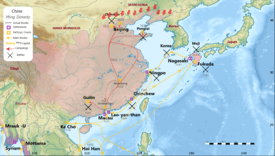
From 1513 with Jorge Álvares, Portugal came into contact with China for the first time [70] trying to establish colonies over 40 years along the Chinese coast and islands resulting in several naval battles and some massacres of colonists by imperial troops. Since the establishment of the Portuguese in Japan [71] and the continued presence in the China Sea, the Portuguese began to act as interlocutors between Japan and India linking China to the rest of the world. In 1554 the Celestial Empire [72] saw with good the creation of a Portuguese Port in the region, giving way with a concession for the help that the Portuguese provided in the elimination of piracy. Macau became a Portuguese colony in the next 445 years [73].
With the crisis of the Ming dynasty and the presence of the Jesuits at the Ming Court [74] [75], Emperor Tianqui (1621-1627)[76] and later Emperor Chongzhen (1628-1644)[76] [77]before the Manchus Invasions that would initiate the Quing Dynasty, summons several times the military assistance of men and weapons (especially cannons and gunners)[78] to the Portuguese from Macau. These were to train Chinese troops or command regiments accompanied by the Jesuits who mastered the Chinese language.[78]
Later after de fall of Beijing in1644 and the last Ming Emperor commited suicide , his wife and empress , now called "Helena" and other members of the imperial Ming family are baptized in 1648 [79] .
Late imperial

The Qing dynasty, which lasted from 1644 until 1912, was the last imperial dynasty of China. Its conquest of the Ming (1618–1683) cost 25 million lives and the economy of China shrank drastically.[81] After the Southern Ming ended, the further conquest of the Dzungar Khanate added Mongolia, Tibet and Xinjiang to the empire.[82] The centralized autocracy was strengthened to crack down on anti-Qing sentiment with the policy of valuing agriculture and restraining commerce, the Haijin ("sea ban"), and ideological control as represented by the literary inquisition, causing social and technological stagnation.[83][84] In the mid-19th century, the dynasty experienced Western imperialism in the Opium Wars with Britain and France. China was forced to pay compensation, open treaty ports, allow extraterritoriality for foreign nationals, and cede Hong Kong to the British[85] under the 1842 Treaty of Nanking, the first of the Unequal Treaties. The First Sino-Japanese War (1894–95) resulted in Qing China's loss of influence in the Korean Peninsula, as well as the cession of Taiwan to Japan.[86]

The Qing dynasty also began experiencing internal unrest in which tens of millions of people died, especially in the White Lotus Rebellion, the failed Taiping Rebellion that ravaged southern China in the 1850s and 1860s and the Dungan Revolt (1862–77) in the northwest. The initial success of the Self-Strengthening Movement of the 1860s was frustrated by a series of military defeats in the 1880s and 1890s.
In the 19th century, the great Chinese diaspora began. Losses due to emigration were added to by conflicts and catastrophes such as the Northern Chinese Famine of 1876–79, in which between 9 and 13 million people died.[87] The Guangxu Emperor drafted a reform plan in 1898 to establish a modern constitutional monarchy, but these plans were thwarted by the Empress Dowager Cixi. The ill-fated anti-foreign Boxer Rebellion of 1899–1901 further weakened the dynasty. Although Cixi sponsored a program of reforms, the Xinhai Revolution of 1911–12 brought an end to the Qing dynasty and established the Republic of China.
Republic (1912–1949)

On 1 January 1912, the Republic of China was established, and Sun Yat-sen of the Kuomintang (the KMT or Nationalist Party) was proclaimed provisional president.[88] However, the presidency was later given to Yuan Shikai, a former Qing general who in 1915 proclaimed himself Emperor of China. In the face of popular condemnation and opposition from his own Beiyang Army, he was forced to abdicate and re-establish the republic.[89]
After Yuan Shikai's death in 1916, China was politically fragmented. Its Beijing-based government was internationally recognized but virtually powerless; regional warlords controlled most of its territory.[90][91] In the late 1920s, the Kuomintang, under Chiang Kai-shek, the then Principal of the Republic of China Military Academy, was able to reunify the country under its own control with a series of deft military and political manoeuvrings, known collectively as the Northern Expedition.[92][93] The Kuomintang moved the nation's capital to Nanjing and implemented "political tutelage", an intermediate stage of political development outlined in Sun Yat-sen's San-min program for transforming China into a modern democratic state.[94][95] The political division in China made it difficult for Chiang to battle the communist People's Liberation Army (PLA), against whom the Kuomintang had been warring since 1927 in the Chinese Civil War. This war continued successfully for the Kuomintang, especially after the PLA retreated in the Long March, until Japanese aggression and the 1936 Xi'an Incident forced Chiang to confront Imperial Japan.[96]

The Second Sino-Japanese War (1937–1945), a theater of World War II, forced an uneasy alliance between the Kuomintang and the PLA. Japanese forces committed numerous war atrocities against the civilian population; in all, as many as 20 million Chinese civilians died.[97] An estimated 40,000 to 300,000 Chinese were massacred in the city of Nanjing alone during the Japanese occupation.[98] During the war, China, along with the UK, the US, and the Soviet Union, were referred to as "trusteeship of the powerful"[99] and were recognized as the Allied "Big Four" in the Declaration by United Nations.[100][101] Along with the other three great powers, China was one of the four major Allies of World War II, and was later considered one of the primary victors in the war.[102][103] After the surrender of Japan in 1945, Taiwan, including the Pescadores, was returned to Chinese control. China emerged victorious but war-ravaged and financially drained. The continued distrust between the Kuomintang and the Communists led to the resumption of civil war. Constitutional rule was established in 1947, but because of the ongoing unrest, many provisions of the ROC constitution were never implemented in mainland China.[104]
People's Republic (1949–present)

Major combat in the Chinese Civil War ended in 1949 with the Communist Party in control of most of mainland China, and the Kuomintang retreating offshore, reducing its territory to only Taiwan, Hainan, and their surrounding islands. On 21 September 1949, Communist Party Chairman Mao Zedong proclaimed the establishment of the People's Republic of China with a speech at the First Plenary Session of the Chinese People's Political Consultative Conference[105][106][107] followed by a public proclamation and celebration in Tiananmen Square.[108] In 1950, the People's Liberation Army captured Hainan from the ROC[109] and incorporated Tibet.[110] However, remaining Kuomintang forces continued to wage an insurgency in western China throughout the 1950s.[111]
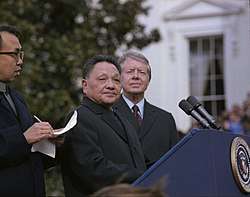
The regime consolidated its popularity among the peasants through land reform, which included the execution of between 1 and 2 million landlords.[112] China developed an independent industrial system and its own nuclear weapons.[113] The Chinese population increased from 550 million in 1950 to 900 million in 1974.[114] However, the Great Leap Forward, an idealistic massive reform project, resulted in an estimated 15 to 35 million deaths between 1958 and 1961, mostly from starvation.[115][116][117] In 1966, Mao and his allies launched the Cultural Revolution, sparking a decade of political recrimination and social upheaval that lasted until Mao's death in 1976. In October 1971, the PRC replaced the Republic in the United Nations, and took its seat as a permanent member of the Security Council.[118]
After Mao's death, the Gang of Four was quickly arrested and held responsible for the excesses of the Cultural Revolution. Deng Xiaoping took power in 1978, and instituted significant economic reforms. The Party loosened governmental control over citizens' personal lives, and the communes were gradually disbanded in favor of working contracted to households. This marked China's transition from a planned economy to a mixed economy with an increasingly open-market environment.[119] China adopted its current constitution on 4 December 1982. In 1989, the violent suppression of student protests in Tiananmen Square brought sanctions against the Chinese government from various countries.[120]

Jiang Zemin, Li Peng and Zhu Rongji led the nation in the 1990s. Under their administration, China's economic performance pulled an estimated 150 million peasants out of poverty and sustained an average annual gross domestic product growth rate of 11.2%.[121][122] The country joined the World Trade Organization in 2001, and maintained its high rate of economic growth under Hu Jintao and Wen Jiabao's leadership in the 2000s. However, the growth also severely impacted the country's resources and environment,[123][124] and caused major social displacement.[125][126]
Chinese Communist Party general secretary Xi Jinping has ruled since 2012 and has pursued large-scale efforts to reform China's economy [127][128] (which has suffered from structural instabilities and slowing growth),[129][130][131] and has also reformed the one-child policy and prison system,[132] as well as instituting a vast anti corruption crackdown.[133]
In December 2019, a new strain of coronavirus, subsequently named COVID-19, broke out in Wuhan, Hubei, then spread to other provinces of China, and eventually around the world, becoming the worldwide COVID-19 pandemic.[134][135]
Geography
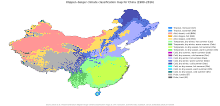
China's landscape is vast and diverse, ranging from the Gobi and Taklamakan Deserts in the arid north to the subtropical forests in the wetter south. The Himalaya, Karakoram, Pamir and Tian Shan mountain ranges separate China from much of South and Central Asia. The Yangtze and Yellow Rivers, the third- and sixth-longest in the world, respectively, run from the Tibetan Plateau to the densely populated eastern seaboard. China's coastline along the Pacific Ocean is 14,500 kilometers (9,000 mi) long and is bounded by the Bohai, Yellow, East China and South China seas. China connects through the Kazakh border to the Eurasian Steppe which has been an artery of communication between East and West since the Neolithic through the Steppe route – the ancestor of the terrestrial Silk Road(s).
Landscape and climate
The territory of China lies between latitudes 18° and 54° N, and longitudes 73° and 135° E. The geographical center of China is marked by the Center of the Country Monument at 35°50′40.9″N 103°27′7.5″E. China's landscapes vary significantly across its vast territory. In the east, along the shores of the Yellow Sea and the East China Sea, there are extensive and densely populated alluvial plains, while on the edges of the Inner Mongolian plateau in the north, broad grasslands predominate. Southern China is dominated by hills and low mountain ranges, while the central-east hosts the deltas of China's two major rivers, the Yellow River and the Yangtze River. Other major rivers include the Xi, Mekong, Brahmaputra and Amur. To the west sit major mountain ranges, most notably the Himalayas. High plateaus feature among the more arid landscapes of the north, such as the Taklamakan and the Gobi Desert. The world's highest point, Mount Everest (8,848 m), lies on the Sino-Nepalese border.[137] The country's lowest point, and the world's third-lowest, is the dried lake bed of Ayding Lake (−154m) in the Turpan Depression.[138]
China's climate is mainly dominated by dry seasons and wet monsoons, which lead to pronounced temperature differences between winter and summer. In the winter, northern winds coming from high-latitude areas are cold and dry; in summer, southern winds from coastal areas at lower latitudes are warm and moist.[139] The climate in China differs from region to region because of the country's highly complex topography.
A major environmental issue in China is the continued expansion of its deserts, particularly the Gobi Desert.[140][141] Although barrier tree lines planted since the 1970s have reduced the frequency of sandstorms, prolonged drought and poor agricultural practices have resulted in dust storms plaguing northern China each spring, which then spread to other parts of East Asia, including Japan and Korea. China's environmental watchdog, SEPA, stated in 2007 that China is losing 4,000 km2 (1,500 sq mi) per year to desertification.[142] Water quality, erosion, and pollution control have become important issues in China's relations with other countries. Melting glaciers in the Himalayas could potentially lead to water shortages for hundreds of millions of people.[143]
Much of China has a climate very suitable for agriculture and the country recently has been the world's largest producer of rice, wheat, tomatoes, eggplant, grapes, watermelon, spinach, and many other crops.[144]
Biodiversity
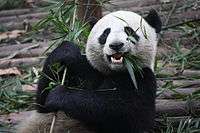
China is one of 17 megadiverse countries,[145] lying in two of the world's major biogeographic realms: the Palearctic and the Indomalayan. By one measure, China has over 34,687 species of animals and vascular plants, making it the third-most biodiverse country in the world, after Brazil and Colombia.[146] The country signed the Rio de Janeiro Convention on Biological Diversity on 11 June 1992, and became a party to the convention on 5 January 1993.[147] It later produced a National Biodiversity Strategy and Action Plan, with one revision that was received by the convention on 21 September 2010.[148]
China is home to at least 551 species of mammals (the third-highest such number in the world),[149] 1,221 species of birds (eighth),[150] 424 species of reptiles (seventh)[151] and 333 species of amphibians (seventh).[152] Wildlife in China share habitat with and bear acute pressure from the world's largest population of Homo sapiens. At least 840 animal species are threatened, vulnerable or in danger of local extinction in China, due mainly to human activity such as habitat destruction, pollution and poaching for food, fur and ingredients for traditional Chinese medicine.[153] Endangered wildlife is protected by law, and as of 2005, the country has over 2,349 nature reserves, covering a total area of 149.95 million hectares, 15 percent of China's total land area.[154] The Baiji was confirmed extinct on 12 December 2006.[155]
China has over 32,000 species of vascular plants,[156] and is home to a variety of forest types. Cold coniferous forests predominate in the north of the country, supporting animal species such as moose and Asian black bear, along with over 120 bird species.[157] The understorey of moist conifer forests may contain thickets of bamboo. In higher montane stands of juniper and yew, the bamboo is replaced by rhododendrons. Subtropical forests, which are predominate in central and southern China, support as many as 146,000 species of flora.[157] Tropical and seasonal rainforests, though confined to Yunnan and Hainan Island, contain a quarter of all the animal and plant species found in China.[157] China has over 10,000 recorded species of fungi,[158] and of them, nearly 6,000 are higher fungi.[159]
Environmental issues
In recent decades, China has suffered from severe environmental deterioration and pollution.[160][161] While regulations such as the 1979 Environmental Protection Law are fairly stringent, they are poorly enforced, as they are frequently disregarded by local communities and government officials in favor of rapid economic development.[162] China is the country with the second highest death toll because of air pollution, after India. There are approximately 1 million deaths caused by exposure to ambient air pollution.[163][164] China is the world's largest carbon dioxide emitter.[165] The country also has significant water pollution problems: 8.2% of China's rivers had been polluted by industrial and agricultural waste in 2019, and were unfit for use.[166][167]
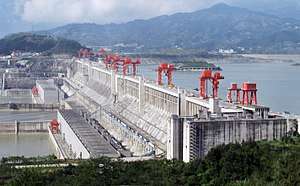
However, China is the world's leading investor in renewable energy and its commercialization, with $52 billion invested in 2011 alone;[168][169][170] it is a major manufacturer of renewable energy technologies and invests heavily in local-scale renewable energy projects.[171][172][173] By 2015, over 24% of China's energy was derived from renewable sources, while most notably from hydroelectric power: a total installed capacity of 197 GW makes China the largest hydroelectric power producer in the world.[174][175] China also has the largest power capacity of installed solar photovoltaics system and wind power system in the world.[176][177]
Political geography

The People's Republic of China is the second-largest country in the world by land area[178] after Russia, and is the third largest by total area, after Russia and Canada.[lower-alpha 18] China's total area is generally stated as being approximately 9,600,000 km2 (3,700,000 sq mi).[179] Specific area figures range from 9,572,900 km2 (3,696,100 sq mi) according to the Encyclopædia Britannica,[180] to 9,596,961 km2 (3,705,407 sq mi) according to the UN Demographic Yearbook,[3] and the CIA World Factbook.[6]
China has the longest combined land border in the world, measuring 22,117 km (13,743 mi) from the mouth of the Yalu River (Amnok River) to the Gulf of Tonkin.[6] China borders 14 nations, more than any other country except Russia, which also borders 14.[181] China extends across much of East Asia, bordering Vietnam, Laos, and Myanmar (Burma) in Southeast Asia; India, Bhutan, Nepal, Afghanistan, and Pakistan[lower-alpha 19] in South Asia; Tajikistan, Kyrgyzstan and Kazakhstan in Central Asia; and Russia, Mongolia, and North Korea in Inner Asia and Northeast Asia. Additionally, China shares maritime boundaries with South Korea, Japan, Vietnam, and the Philippines.
Politics
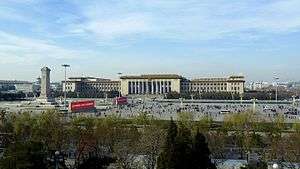
The Chinese constitution states that The People's Republic of China "is a socialist state under the people's democratic dictatorship led by the working class and based on the alliance of workers and peasants," and that the state organs "apply the principle of democratic centralism."[182] The PRC is one of the world's only socialist states explicitly aiming to build communism. The Chinese government has been variously described as communist and socialist, but also as authoritarian and corporatist,[183] with heavy restrictions in many areas, most notably against free access to the Internet, freedom of the press, freedom of assembly, the right to have children, free formation of social organizations and freedom of religion.[184] Its current political, ideological and economic system has been termed by its leaders as a "consultative democracy" "people's democratic dictatorship", "socialism with Chinese characteristics" (which is Marxism adapted to Chinese circumstances) and the "socialist market economy" respectively.[185][186] According to Lutgard Lams, "President Xi is making great attempts to 'Sinicize' Marxist–Leninist Thought 'with Chinese characteristics' in the political sphere."[187]
Communist Party
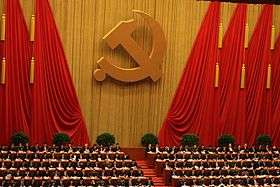
Since 2018, the main body of the Chinese constitution declares that "the defining feature of socialism with Chinese characteristics is the leadership of the Communist Party of China (CPC)."[188] The 2018 amendments constitutionalized the de facto one-party state status of China,[188] wherein the General Secretary (party leader) holds ultimate power and authority over state and government and serves as the paramount leader of China.[189] The current General Secretary is Xi Jinping, who took office on 15 November 2012 and was re-elected on 25 October 2017. The electoral system is pyramidal. Local People's Congresses are directly elected, and higher levels of People's Congresses up to the National People's Congress (NPC) are indirectly elected by the People's Congress of the level immediately below.[182] The political system is decentralized, and provincial and sub-provincial leaders have a significant amount of autonomy.[190] Another eight political parties, have representatives in the NPC and the Chinese People's Political Consultative Conference (CPPCC).[191] China supports the Leninist principle of "democratic centralism",[182] but critics describe the elected National People's Congress as a "rubber stamp" body.[192]
Government

The President is the titular head of state, elected by the National People's Congress. The Premier is the head of government, presiding over the State Council composed of four vice premiers and the heads of ministries and commissions. The incumbent president is Xi Jinping, who is also the General Secretary of the Communist Party of China and the Chairman of the Central Military Commission, making him China's paramount leader. The incumbent premier is Li Keqiang, who is also a senior member of the CPC Politburo Standing Committee, China's de facto top decision-making body.[193][194]
There have been some moves toward political liberalization, in that open contested elections are now held at the village and town levels.[195][196] However, the party retains effective control over government appointments: in the absence of meaningful opposition, the CPC wins by default most of the time. In 2017, Xi called on the communist party to further tighten its grip on the country, to uphold the unity of the party leadership, and achieve the "Chinese Dream of national rejuvenation".[185][197] Political concerns in China include the growing gap between rich and poor and government corruption.[198] Nonetheless, the level of public support for the government and its management of the nation is high, with 80–95% of Chinese citizens expressing satisfaction with the central government, according to a 2011 survey.[199]
Administrative divisions
The People's Republic of China is divided into 22 provinces, five autonomous regions (each with a designated minority group), and four municipalities—collectively referred to as "mainland China"—as well as the special administrative regions (SARs) of Hong Kong and Macau. Geographically, all 31 provincial divisions of mainland China can be grouped into six regions: North China, Northeast China, East China, South Central China, Southwest China, and Northwest China.
China considers Taiwan to be its 23rd province, although Taiwan is governed by the Republic of China (ROC), which rejects the PRC's claim. Conversely, the ROC claims sovereignty over all divisions governed by the PRC.
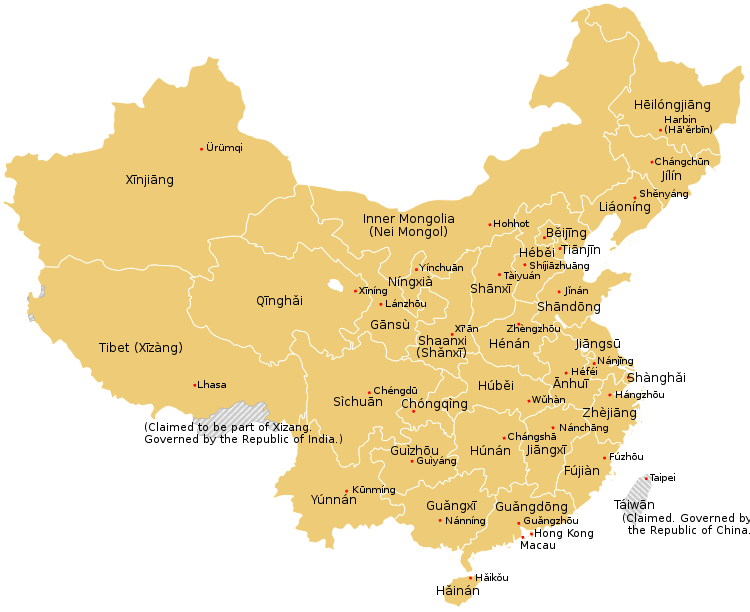

| Provinces (省) | Claimed Province | ||||
|---|---|---|---|---|---|
|
|||||
| Autonomous regions (自治区) | Municipalities (直辖市) | Special administrative regions (特别行政区) | |||
|
|||||
Foreign relations
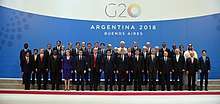
The PRC has diplomatic relations with 175 countries and maintains embassies in 162. Its legitimacy is disputed by the Republic of China and a few other countries; it is thus the largest and most populous state with limited recognition. In 1971, the PRC replaced the Republic of China as the sole representative of China in the United Nations and as one of the five permanent members of the United Nations Security Council.[200] China was also a former member and leader of the Non-Aligned Movement, and still considers itself an advocate for developing countries.[201] Along with Brazil, Russia, India and South Africa, China is a member of the BRICS group of emerging major economies and hosted the group's third official summit at Sanya, Hainan in April 2011.[202]
Under its interpretation of the One-China policy, Beijing has made it a precondition to establishing diplomatic relations that the other country acknowledges its claim to Taiwan and severs official ties with the government of the Republic of China. Chinese officials have protested on numerous occasions when foreign countries have made diplomatic overtures to Taiwan,[203] especially in the matter of armament sales.[204]
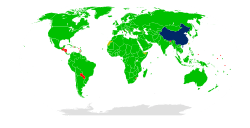
Much of current Chinese foreign policy is reportedly based on Premier Zhou Enlai's Five Principles of Peaceful Coexistence, and is also driven by the concept of "harmony without uniformity", which encourages diplomatic relations between states despite ideological differences.[205] This policy may have led China to support states that are regarded as dangerous or repressive by Western nations, such as Zimbabwe, North Korea and Iran.[206] China has a close economic and military relationship with Russia,[207] and the two states often vote in unison in the UN Security Council.[208][209][210]
Trade relations
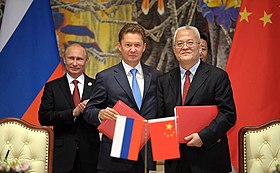
China became the world's largest trading nation in 2013, as measured by the sum of imports and exports.[211] By 2016, China was the largest trading partner of 124 other countries.[212] China became a member of the World Trade Organization (WTO) on 11 December 2001. In 2004, it proposed an entirely new East Asia Summit (EAS) framework as a forum for regional security issues.[213] The EAS, which includes ASEAN Plus Three, India, Australia and New Zealand, held its inaugural summit in 2005.
China has had a long and complex trade relationship with the United States. In 2000, the United States Congress approved "permanent normal trade relations" (PNTR) with China, allowing Chinese exports in at the same low tariffs as goods from most other countries.[214] China has a significant trade surplus with the United States, its most important export market.[215] In the early 2010s, US politicians argued that the Chinese yuan was significantly undervalued, giving China an unfair trade advantage.[216][217][218]
Since the turn of the century, China has followed a policy of engaging with African nations for trade and bilateral co-operation;[219][220][221] in 2012, Sino-African trade totalled over US$160 billion.[222] China maintains healthy and highly diversified trade links with the European Union. China has furthermore strengthened its ties with major South American economies, becoming the largest trading partner of Brazil[223] and building strategic links with Argentina.[224]
China's Belt and Road Initiative has expanded significantly over the last six years and, as of 2019, includes 137 countries and 30 international organizations.
Territorial disputes
Taiwan
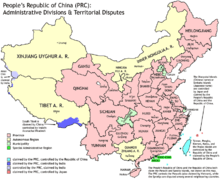
Ever since its establishment after the second Chinese Civil War, the PRC has claimed the territories governed by the Republic of China (ROC), a separate political entity today commonly known as Taiwan, as a part of its territory. It regards the island of Taiwan as its Taiwan Province, Kinmen and Matsu as a part of Fujian Province and islands the ROC controls in the South China Sea as a part of Hainan Province and Guangdong Province. These claims are controversial because of the complicated Cross-Strait relations, with the PRC treating the One-China policy as one of its most important diplomatic principles.[225]
Land border disputes
China has resolved its land borders with 12 out of 14 neighboring countries, having pursued substantial compromises in most of them.[226][227][228] As of 2020, China currently has a disputed land border with only India and Bhutan.
Maritime border disputes
China is additionally involved in maritime disputes with multiple countries over the ownership of several small islands in the East and South China Seas, such as the Senkaku Islands and the Scarborough Shoal.[229][230]
Sociopolitical issues and human rights

The Chinese democracy movement, social activists, and some members of the Communist Party of China believe in the need for social and political reform. While economic and social controls have been significantly relaxed in China since the 1970s, political freedom is still tightly restricted. The Constitution of the People's Republic of China states that the "fundamental rights" of citizens include freedom of speech, freedom of the press, the right to a fair trial, freedom of religion, universal suffrage, and property rights. However, in practice, these provisions do not afford significant protection against criminal prosecution by the state.[231][232] Although some criticisms of government policies and the ruling Communist Party are tolerated, censorship of political speech and information, most notably on the Internet,[233][234] are routinely used to prevent collective action.[235] By 2020, China plans to give all its citizens a personal "Social Credit" score based on how they behave.[236] The Social Credit System, now being piloted in a number of Chinese cities, is considered a form of mass surveillance which uses big data analysis technology.[237][238]
A number of foreign governments, foreign press agencies, and NGOs have criticized China's human rights record, alleging widespread civil rights violations such as detention without trial, forced abortions,[239] forced confessions, torture, restrictions of fundamental rights,[184][240] and excessive use of the death penalty.[241][242] The government suppresses popular protests and demonstrations that it considers a potential threat to "social stability", as was the case with the Tiananmen Square protests of 1989.[243]
.jpg)
Falun Gong, a religious meditation movement, was first taught publicly in 1992. In 1999, when there were about 70 million practitioners,[244] the persecution of Falun Gong began, resulting in mass arrests, extralegal detention, and alleged reports of torture and deaths in custody.[245][246]
The Chinese state is regularly accused of large-scale repression and human rights abuses in Tibet[247] and Xinjiang,[248] including violent police crackdowns and religious suppression throughout the Chinese nation.[249][250] At least one million members of China's Muslim Uyghur minority have been detained in mass detention camps, termed "Vocational Education and Training Centers", aimed at changing the political thinking of detainees, their identities, and their religious beliefs.[251] According to the U.S. Department of State, actions including political indoctrination, torture, physical and psychological abuse, forced sterilization, sexual abuse, and forced labor are common in these facilities.[252] In January 2019, the United Nations asked for direct access to the detention camps after a panel said it had received "credible reports" that 1.1 million Uygur, Kazakhs, Hui and other ethnic minorities had been detained in these camps.[253] The state has also sought to control offshore reporting of tensions in Xinjiang, intimidating foreign-based reporters by detaining their family members.[254]
The Global Slavery Index estimated that in 2016 more than 3.8 million people were living in "conditions of modern slavery", or 0.25% of the population, including victims of human trafficking, forced labor, forced marriage, child labor, and state-imposed forced labor. The state-imposed forced system was formally abolished in 2013 but it is not clear the extent to which its various practices have stopped.[255] The Chinese penal system includes labor prison factories, detention centers, and re-education camps, which fall under the heading Laogai ("reform through labor"). The Laogai Research Foundation in the United States estimated that there were over a thousand slave labour prisons and camps, known collectively as the Laogai.[256]
An independent tribunal convened to study the issue of forced organ harvesting in China[257] concluded that,
Forced organ harvesting has been committed for years throughout China on a significant scale and that Falun Gong practitioners have been one - and probably the main - source of organ supply. The concerted persecution and medical testing of the Uyghurs is more recent and it may be that evidence of forced organ harvesting of this group may emerge in due course. The Tribunal has had no evidence that the significant infrastructure associated with China’s transplantation industry has been dismantled and absent a satisfactory explanation as to the source of readily available organs concludes that forced organ harvesting continues till today.
In 2019 a study called for the mass retraction of more than 400 scientific papers on organ transplantation, because of fears the organs were obtained unethically from Chinese prisoners. While the government says 10,000 transplants occur each year, hospital data shows between 60,000 and 100,000 organs are transplanted each year. The report provided evidence that this gap is being made up by executed prisoners of conscience.[258]
Military
_51.jpg)
With 2.3 million active troops, the People's Liberation Army (PLA) is the largest standing military force in the world, commanded by the Central Military Commission (CMC).[259] China has the second-biggest military reserve force, only behind North Korea. The PLA consists of the Ground Force (PLAGF), the Navy (PLAN), the Air Force (PLAAF), and the People's Liberation Army Rocket Force (PLARF). According to the Chinese government, China's military budget for 2017 totalled US$151.5 billion, constituting the world's second-largest military budget, although the military expenditures-GDP ratio with 1.3% of GDP is below world average.[260] However, many authorities – including SIPRI and the U.S. Office of the Secretary of Defense – argue that China does not report its real level of military spending, which is allegedly much higher than the official budget.[260][261]
Economy
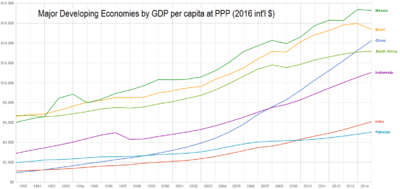
Since 2010, China had the world's second-largest economy in terms of nominal GDP,[263] totaling approximately US$13.5 trillion (90 trillion Yuan) as of 2018.[264] In terms of purchasing power parity (PPP GDP), China's economy has been the largest in the world since 2014, according to the World Bank.[265] According to the World Bank, China's GDP grew from $150 billion in 1978 to $13.6 trillion by 2018.[266] China's economic growth has been consistently above 6 percent since the introduction of economic reforms in 1978.[267] China is also the world's largest exporter and second-largest importer of goods.[268] Between 2010 and 2019, China's contribution to global GDP growth has been 25% to 39%.[269][270]
China had the largest economy in the world for most of the past two thousand years, during which it has seen cycles of prosperity and decline.[271][272] Since economic reforms began in 1978, China has developed into a highly diversified economy and one of the most consequential players in international trade. Major sectors of competitive strength include manufacturing, retail, mining, steel, textiles, automobiles, energy generation, green energy, banking, electronics, telecommunications, real estate, e-commerce, and tourism. China has three out of the ten largest stock exchanges in the world—Shanghai, Hong Kong and Shenzhen—that together have a market capitalization of over $10 trillion, as of 2019.[273]
China has been the world's No. 1 manufacturer since 2010, after overtaking the US, which had been No. 1 for the previous hundred years.[274][275] China has also been No. 2 in high-tech manufacturing since 2012, according to US National Science Foundation.[276] China is the second largest retail market in the world, next to the United States.[277] China leads the world in e-commerce, accounting for 40% of the global market share in 2016[278] and more than 50% of the global market share in 2019.[279] China is the world's leader in electric vehicles, manufacturing and buying half of all the plug-in electric cars (BEV and PHEV) in the world in 2018.[280] China had 174 GW of installed solar capacity by the end of 2018, which amounts to more than 40% of the global solar capacity.[281][282]
As of 2018, China was first in the world in total number of billionaires and second in millionaires—there were 658 Chinese billionaires[283] and 3.5 million millionaires.[284] However, it ranks behind over 70 countries (out of around 180) in per capita economic output, making it a middle income country.[285] Additionally, its development is highly uneven. Its major cities and coastal areas are far more prosperous compared to rural and interior regions.[286] China brought more people out of extreme poverty than any other country in history[287]—between 1978 and 2018, China reduced extreme poverty by 800 million. China reduced the extreme poverty rate—per international standard, it refers to an income of less than $1.90/day—from 88% in 1981 to 1.85% by 2013.[288] According to the World Bank, the number of Chinese in extreme poverty fell from 756 million to 25 million between 1990 and 2013.[289] China's own national poverty standards are higher and thus the national poverty rates were 3.1% in 2017[290] and 1% in 2018.[291]
In 2019, China overtook the US as the home to the highest number of rich people in the world, according to the global wealth report by Credit Suisse.[292][293] In other words, as of 2019, 100 million Chinese are in the top 10% of the wealthiest individuals in the world—those who have a net personal wealth of at least $110,000.[294]
Economic growth
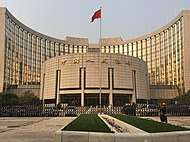

From its founding in 1949 until late 1978, the People's Republic of China was a Soviet-style centrally planned economy. Following Mao's death in 1976 and the consequent end of the Cultural Revolution, Deng Xiaoping and the new Chinese leadership began to reform the economy and move towards a more market-oriented mixed economy under one-party rule. Agricultural collectivization was dismantled and farmlands privatized, while foreign trade became a major new focus, leading to the creation of Special Economic Zones (SEZs). Inefficient state-owned enterprises (SOEs) were restructured and unprofitable ones were closed outright, resulting in massive job losses. Modern-day China is mainly characterized as having a market economy based on private property ownership,[297] and is one of the leading examples of state capitalism.[298][299] The state still dominates in strategic "pillar" sectors such as energy production and heavy industries, but private enterprise has expanded enormously, with around 30 million private businesses recorded in 2008.[300][301][302][303] In 2018, private enterprises in China accounted for 60% of GDP, 80% of urban employment and 90% of new jobs.[304]
In the early 2010s, China's economic growth rate began to slow amid domestic credit troubles, weakening international demand for Chinese exports and fragility in the global economy.[305][306][307] China's GDP was smaller than Germany's in 2007; however, by 2017, China's $12.2 trillion-economy became larger than those of Germany, UK, France and Italy combined.[308] In 2018, the IMF reiterated its forecast that China will overtake the US in terms of nominal GDP by the year 2030.[309] Economists also expect China's middle class to expand to 600 million people by 2025.[310]
China in the global economy
| Share of world GDP (PPP)[311] | |
|---|---|
| Year | Share |
| 1980 | 2.32% |
| 1990 | 4.11% |
| 2000 | 7.40% |
| 2010 | 13.89% |
| 2018 | 18.72% |
China is a member of the WTO and is the world's largest trading power, with a total international trade value of US$4.62 trillion in 2018.[312][313] Its foreign exchange reserves reached US$3.1 trillion as of 2019,[314] making its reserves by far the world's largest.[315][316] In 2012, China was the world's largest recipient of inward foreign direct investment (FDI), attracting $253 billion.[317] In 2014, China's foreign exchange remittances were $US64 billion making it the second largest recipient of remittances in the world.[318] China also invests abroad, with a total outward FDI of $62.4 billion in 2012,[317] and a number of major takeovers of foreign firms by Chinese companies.[319] China is a major owner of US public debt, holding trillions of dollars worth of U.S. Treasury bonds.[320][321] China's undervalued exchange rate has caused friction with other major economies,[217][322][323] and it has also been widely criticized for manufacturing large quantities of counterfeit goods.[324][325]
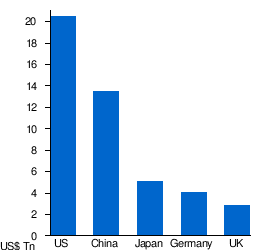 |
| Largest economies by nominal GDP in 2018[326] |
Following the 2007–08 financial crisis, Chinese authorities sought to actively wean off of its dependence on the U.S. Dollar as a result of perceived weaknesses of the international monetary system.[327] To achieve those ends, China took a series of actions to further the internationalization of the Renminbi. In 2008, China established dim sum bond market and expanded the Cross-Border Trade RMB Settlement Pilot Project, which helps establish pools of offshore RMB liquidity.[328][329] This was followed with bilateral agreements to settle trades directly in renminbi with Russia,[330] Japan,[331] Australia,[332] Singapore,[333] the United Kingdom,[334] and Canada.[335] As a result of the rapid internationalization of the renminbi, it became the eighth-most-traded currency in the world, an emerging international reserve currency,[336] and a component of the IMF's special drawing rights; however, partly due to capital controls that make the renminbi fall short of being a fully convertible currency, it remains far behind the Euro, Dollar and Japanese Yen in international trade volumes.[337]
Class and income inequality
China has had the world's largest middle class population since 2015,[338] and the middle class grew to a size of 400 million by 2018.[339] Wages in China have grown exponentially in the last 40 years—real (inflation-adjusted) wages grew seven-fold from 1978 to 2007.[340] By 2018, median wages in Chinese cities such as Shanghai were about the same as or higher than the wages in Eastern European countries.[341] China has the world's second-highest number of billionaires, with nearly 400 as of 2018, increasing at the rate of roughly two per week.[342][343] China has a high level of economic inequality,[344] which has increased in the past few decades.[345] In 2018 China's GINI index was 0.467, according to the World Bank.[10]
Science and technology
Historical
China was once a world leader in science and technology up until the Ming dynasty.[346] Ancient Chinese discoveries and inventions, such as papermaking, printing, the compass, and gunpowder (the Four Great Inventions), became widespread across East Asia, the Middle East and later to Europe. Chinese mathematicians were the first to use negative numbers.[347][348] By the 17th century, Europe and the Western world surpassed China in scientific and technological advancement.[349] The causes of this early modern Great Divergence continue to be debated by scholars to this day.[350]
After repeated military defeats by the European colonial powers and Japan in the 19th century, Chinese reformers began promoting modern science and technology as part of the Self-Strengthening Movement. After the Communists came to power in 1949, efforts were made to organize science and technology based on the model of the Soviet Union, in which scientific research was part of central planning.[351] After Mao's death in 1976, science and technology was established as one of the Four Modernizations,[352] and the Soviet-inspired academic system was gradually reformed.[353]
Modern era
Since the end of the Cultural Revolution, China has made significant investments in scientific research[355] and is quickly catching up with the US in R&D spending.[356] In 2017, China spent $279 billion on scientific research and development.[357] According to the OECD, China spent 2.11% of its GDP on research and development (R&D) in 2016.[358] Science and technology are seen as vital for achieving China's economic and political goals, and are held as a source of national pride to a degree sometimes described as "techno-nationalism".[359] In 2017, China was No. 2 in international patents application, behind the US but ahead of Japan.[360] Chinese tech companies Huawei and ZTE were the top 2 filers of international patents in 2017.[361][362] Chinese-born scientists have won the Nobel Prize in Physics four times, the Nobel Prize in Chemistry and Physiology or Medicine once respectively, though most of these scientists conducted their Nobel-winning research in western nations.[lower-alpha 20]
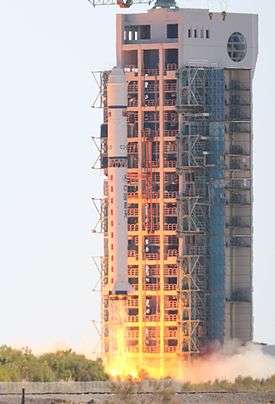
China is developing its education system with an emphasis on science, mathematics and engineering; in 2009, China graduated over 10,000 PhD engineers, and as many as 500,000 BSc graduates, more than any other country.[368] China also became the world's largest publisher of scientific papers in 2016.[369] Chinese technology companies such as Huawei and Lenovo have become world leaders in telecommunications and personal computing,[370][371][372] and Chinese supercomputers are consistently ranked among the world's most powerful.[373][374] China has been the world's largest market for industrial robots since 2013 and will account for 45% of newly installed robots from 2019–2021.[375]
The Chinese space program is one of the world's most active. In 1970, China launched its first satellite, Dong Fang Hong I, becoming the fifth country to do so independently.[376] In 2003, China became the third country to independently send humans into space, with Yang Liwei's spaceflight aboard Shenzhou 5; as of 2015, ten Chinese nationals have journeyed into space, including two women. In 2011, China's first space station module, Tiangong-1, was launched, marking the first step in a project to assemble a large manned station by the early 2020s.[377] In 2013, China successfully landed the Chang'e 3 lander and Yutu rover onto the lunar surface.[378] In 2019, China became the first country to land a probe—Chang'e 4—on the far side of the moon.
Infrastructure
Telecommunications

China is the largest telecom market in the world and currently has the largest number of active cellphones of any country in the world, with over 1.5 billion subscribers, as of 2018.[379] It also has the world's largest number of internet and broadband users, with over 800 million Internet users as of 2018—equivalent to around 60% of its population—and almost all of them being mobile as well.[380] By 2018, China had more than 1 billion 4G users, accounting for 40% of world's total.[381][382] China is making rapid advances in 5G—by late 2018, China had started large-scale and commercial 5G trials.[383]
China Mobile, China Unicom and China Telecom, are the three large providers of mobile and internet in China. China Telecom alone served more than 145 million broadband subscribers and 300 million mobile users; China Unicom had about 300 million subscribers; and China Mobile, the biggest of them all, had 925 million users, as of 2018.[384][385][386] Combined, the three operators had over 3.4 million 4G base-stations in China.[387] Several Chinese telecommunications companies, most notably Huawei and ZTE, have been accused of spying for the Chinese military.[388]
China is developing its own satellite navigation system, dubbed Beidou, which began offering commercial navigation services across Asia in 2012[389] and it started providing global services by the end of 2018.[390][391] Now China belongs to the elite group of three countries—US and Russia being the other two members—that provide global satellite navigation.
Transport
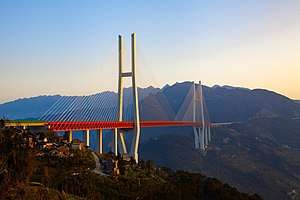
Since the late 1990s, China's national road network has been significantly expanded through the creation of a network of national highways and expressways. In 2018, China's highways had reached a total length of 142,500 km (88,500 mi), making it the longest highway system in the world.[392] China has the world's largest market for automobiles, having surpassed the United States in both auto sales and production. A side-effect of the rapid growth of China's road network has been a significant rise in traffic accidents,[393] though the number of fatalities in traffic accidents fell by 20% from 2007 to 2017.[394] In urban areas, bicycles remain a common mode of transport, despite the increasing prevalence of automobiles – as of 2012, there are approximately 470 million bicycles in China.[395]
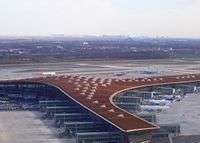
China's railways, which are state-owned, are among the busiest in the world, handling a quarter of the world's rail traffic volume on only 6 percent of the world's tracks in 2006.[396] As of 2017, the country had 127,000 km (78,914 mi) of railways, the second longest network in the world.[397][398] The railways strain to meet enormous demand particularly during the Chinese New Year holiday, when the world's largest annual human migration takes place.[399]
China's high-speed rail (HSR) system started construction in the early 2000s. By the end of 2019, high speed rail in China had over 35,000 kilometers (21,748 miles) of dedicated lines alone, making it the longest HSR network in the world.[400][401] With an annual ridership of over 1.1 billion passengers in 2015 it is the world's busiest.[402] The network includes the Beijing–Guangzhou–Shenzhen High-Speed Railway, the single longest HSR line in the world, and the Beijing–Shanghai High-Speed Railway, which has three of longest railroad bridges in the world.[403] The Shanghai Maglev Train, which reaches 431 km/h (268 mph), is the fastest commercial train service in the world.[404]
Since 2000, the growth of rapid transit systems in Chinese cities has accelerated. As of January 2016, 26 Chinese cities have urban mass transit systems in operation and 39 more have metro systems approved[405] with a dozen more to join them by 2020.[406]
There were approximately 229 airports in 2017, with around 240 planned by 2020. China has over 2,000 river and seaports, about 130 of which are open to foreign shipping. In 2017, the Ports of Shanghai, Hong Kong, Shenzhen, Ningbo-Zhoushan, Guangzhou, Qingdao and Tianjin ranked in the Top 10 in the world in container traffic and cargo tonnage.[407]
Water supply and sanitation
Water supply and sanitation infrastructure in China is facing challenges such as rapid urbanization, as well as water scarcity, contamination, and pollution.[408] According to data presented by the Joint Monitoring Program for Water Supply and Sanitation of WHO and UNICEF in 2015, about 36% of the rural population in China still did not have access to improved sanitation.[409] In June 2010, there were 1,519 sewage treatment plants in China and 18 plants were added each week.[410] The ongoing South–North Water Transfer Project intends to abate water shortage in the north.[411]
Demographics

The national census of 2010 recorded the population of the People's Republic of China as approximately 1,370,536,875. About 16.60% of the population were 14 years old or younger, 70.14% were between 15 and 59 years old, and 13.26% were over 60 years old.[412] The population growth rate for 2013 is estimated to be 0.46%.[413] China used to make up much of the world's poor; now it makes up much of the world's middle class.[414] Although a middle-income country by Western standards, China's rapid growth has pulled hundreds of millions—800 million, to be more precise[415]—of its people out of poverty since 1978. By 2013, less than 2% of the Chinese population lived below the international poverty line of US$1.9 per day, down from 88% in 1981.[288] China's own standards for poverty are higher and still the country is on its way to eradicate national poverty completely by 2019.[416] From 2009–2018, the unemployment rate in China has averaged about 4%.[417]
Given concerns about population growth, China implemented a two-child limit during the 1970s, and, in 1979, began to advocate for an even stricter limit of one child per family. Beginning in the mid 1980s, however, given the unpopularity of the strict limits, China began to allow some major exemptions, particularly in rural areas, resulting in what was actually a "1.5"-child policy from the mid-1980s to 2015 (ethnic minorities were also exempt from one child limits). The next major loosening of the policy was enacted in December 2013, allowing families to have two children if one parent is an only child.[418] In 2016, the one-child policy was replaced in favor of a two-child policy.[419] Data from the 2010 census implies that the total fertility rate may be around 1.4, although due to underreporting of births it may be closer to 1.5–1.6.[420]
According to one group of scholars, one-child limits had little effect on population growth[421] or the size of the total population.[422] However, these scholars have been challenged. Their own counterfactual model of fertility decline without such restrictions implies that China averted more than 500 million births between 1970 and 2015, a number which may reach one billion by 2060 given all the lost descendants of births averted during the era of fertility restrictions, with one-child restrictions accounting for the great bulk of that reduction.[423]
The policy, along with traditional preference for boys, may have contributed to an imbalance in the sex ratio at birth.[424][425] According to the 2010 census, the sex ratio at birth was 118.06 boys for every 100 girls,[426] which is beyond the normal range of around 105 boys for every 100 girls.[427] The 2010 census found that males accounted for 51.27 percent of the total population.[426] However, China's sex ratio is more balanced than it was in 1953, when males accounted for 51.82 percent of the total population.[426]
Ethnic groups
_Tai_L%C3%BC_script_in_Mohan%2C_Yunnan.jpg)
China legally recognizes 56 distinct ethnic groups, who altogether comprise the Zhonghua Minzu. The largest of these nationalities are the ethnic Chinese or "Han", who constitute more than 80% of the total population.[428] The Han Chinese – the world's largest single ethnic group[429] – outnumber other ethnic groups in every provincial-level division except Tibet and Xinjiang.[430] Ethnic minorities account for about less than 25% of the population of China, according to the 2010 census.[428] Compared with the 2000 population census, the Han population increased by 66,537,177 persons, or 5.74%, while the population of the 55 national minorities combined increased by 7,362,627 persons, or 6.92%.[428] The 2010 census recorded a total of 593,832 foreign nationals living in China. The largest such groups were from South Korea (120,750), the United States (71,493) and Japan (66,159).[431]
Languages
There are as many as 292 living languages in China.[432] The languages most commonly spoken belong to the Sinitic branch of the Sino-Tibetan language family, which contains Mandarin (spoken by 70% of the population),[433] and other varieties of Chinese language: Yue (including Cantonese and Taishanese), Wu (including Shanghainese and Suzhounese), Min (including Fuzhounese, Hokkien and Teochew), Xiang, Gan and Hakka. Languages of the Tibeto-Burman branch, including Tibetan, Qiang, Naxi and Yi, are spoken across the Tibetan and Yunnan–Guizhou Plateau. Other ethnic minority languages in southwest China include Zhuang, Thai, Dong and Sui of the Tai-Kadai family, Miao and Yao of the Hmong–Mien family, and Wa of the Austroasiatic family. Across northeastern and northwestern China, local ethnic groups speak Altaic languages including Manchu, Mongolian and several Turkic languages: Uyghur, Kazakh, Kyrgyz, Salar and Western Yugur. Korean is spoken natively along the border with North Korea. Sarikoli, the language of Tajiks in western Xinjiang, is an Indo-European language. Taiwanese aborigines, including a small population on the mainland, speak Austronesian languages.[434]
Standard Mandarin, a variety of Mandarin based on the Beijing dialect, is the official national language of China and is used as a lingua franca in the country between people of different linguistic backgrounds.[435][436] Mongolian, Uyghur, Tibetan, Zhuang and various other languages are also regionally recognized throughout the country.[437]
Chinese characters have been used as the written script for the Sinitic languages for thousands of years. They allow speakers of mutually unintelligible Chinese varieties to communicate with each other through writing. In 1956, the government introduced simplified characters, which have supplanted the older traditional characters in mainland China. Chinese characters are romanized using the Pinyin system. Tibetan uses an alphabet based on an Indic script. Uyghur is most commonly written in Persian alphabet based Uyghur Arabic alphabet. The Mongolian script used in China and the Manchu script are both derived from the Old Uyghur alphabet. Zhuang uses both an official Latin alphabet script and a traditional Chinese character script.
Urbanization
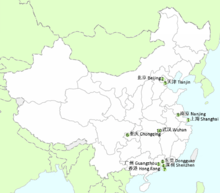
China has urbanized significantly in recent decades. The percent of the country's population living in urban areas increased from 20% in 1980 to over 55% in 2016.[438][439][440][441] It is estimated that China's urban population will reach one billion by 2030, potentially equivalent to one-eighth of the world population.[439][440]
China has over 160 cities with a population of over one million,[442] including the seven megacities (cities with a population of over 10 million) of Chongqing, Shanghai, Beijing, Guangzhou, Tianjin, Shenzhen, and Wuhan.[443][444][445] Shanghai is China's most populous urban area[446][447] while Chongqing is its largest city proper.[448] By 2025, it is estimated that the country will be home to 221 cities with over a million inhabitants.[439] The figures in the table below are from the 2010 census,[449] and are only estimates of the urban populations within administrative city limits; a different ranking exists when considering the total municipal populations (which includes suburban and rural populations). The large "floating populations" of migrant workers make conducting censuses in urban areas difficult;[450] the figures below include only long-term residents.
Education
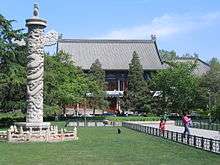
Since 1986, compulsory education in China comprises primary and junior secondary school, which together last for nine years.[452] In 2010, about 82.5 percent of students continued their education at a three-year senior secondary school.[453] The Gaokao, China's national university entrance exam, is a prerequisite for entrance into most higher education institutions. In 2010, 27 percent of secondary school graduates are enrolled in higher education.[454] This number increased significantly over the last years, reaching a tertiary school enrollment of 50 percent in 2018.[455] Vocational education is available to students at the secondary and tertiary level.[456]
In February 2006, the government pledged to provide completely free nine-year education, including textbooks and fees.[457] Annual education investment went from less than US$50 billion in 2003 to more than US$250 billion in 2011.[458] However, there remains an inequality in education spending. In 2010, the annual education expenditure per secondary school student in Beijing totalled ¥20,023, while in Guizhou, one of the poorest provinces in China, only totalled ¥3,204.[459] Free compulsory education in China consists of primary school and junior secondary school between the ages of 6 and 15. In 2011, around 81.4% of Chinese have received secondary education.[460]
As of 2018, 96% of the population over age 15 are literate.[461] In 1949, only 20% of the population could read, compared to 65.5% thirty years later.[462] In 2009, Chinese students from Shanghai achieved the world's best results in mathematics, science and literacy, as tested by the Programme for International Student Assessment (PISA), a worldwide evaluation of 15-year-old school pupils' scholastic performance.[463] Despite the high results, Chinese education has also faced both native and international criticism for its emphasis on rote memorization and its gap in quality from rural to urban areas.[464]
Health

The National Health and Family Planning Commission, together with its counterparts in the local commissions, oversees the health needs of the Chinese population.[465] An emphasis on public health and preventive medicine has characterized Chinese health policy since the early 1950s. At that time, the Communist Party started the Patriotic Health Campaign, which was aimed at improving sanitation and hygiene, as well as treating and preventing several diseases. Diseases such as cholera, typhoid and scarlet fever, which were previously rife in China, were nearly eradicated by the campaign. After Deng Xiaoping began instituting economic reforms in 1978, the health of the Chinese public improved rapidly because of better nutrition, although many of the free public health services provided in the countryside disappeared along with the People's Communes. Healthcare in China became mostly privatized, and experienced a significant rise in quality. In 2009, the government began a 3-year large-scale healthcare provision initiative worth US$124 billion.[466] By 2011, the campaign resulted in 95% of China's population having basic health insurance coverage.[467] In 2011, China was estimated to be the world's third-largest supplier of pharmaceuticals, but its population has suffered from the development and distribution of counterfeit medications.[468]
As of 2017, the average life expectancy at birth in China is 76 years,[469] and the infant mortality rate is 7 per thousand.[470] Both have improved significantly since the 1950s.[lower-alpha 21] Rates of stunting, a condition caused by malnutrition, have declined from 33.1% in 1990 to 9.9% in 2010.[473] Despite significant improvements in health and the construction of advanced medical facilities, China has several emerging public health problems, such as respiratory illnesses caused by widespread air pollution,[474] hundreds of millions of cigarette smokers,[475] and an increase in obesity among urban youths.[476][477] China's large population and densely populated cities have led to serious disease outbreaks in recent years, such as the 2003 outbreak of SARS, although this has since been largely contained.[478] In 2010, air pollution caused 1.2 million premature deaths in China.[479]
The COVID-19 pandemic was first identified in Wuhan in December 2019.[480][481] The Chinese government has been criticized for its handling of the epidemic and accused of concealing the extent of the outbreak before it became an international pandemic.[482]
Religion
Religion in China (CFPS 2014)[483][484][note 2]
The government of the People's Republic of China officially espouses state atheism,[485] and has conducted antireligious campaigns to this end.[486] Religious affairs and issues in the country are overseen by the State Administration for Religious Affairs.[487] Freedom of religion is guaranteed by China's constitution, although religious organizations that lack official approval can be subject to state persecution.[240][488]
Over the millennia, Chinese civilization has been influenced by various religious movements. The "three teachings", including Confucianism, Taoism, and Buddhism (Chinese Buddhism), historically have a significant role in shaping Chinese culture,[489][490] enriching a theological and spiritual framework which harkens back to the early Shang and Zhou dynasty. Chinese popular or folk religion, which is framed by the three teachings and other traditions,[491] consists in allegiance to the shen (神), a character that signifies the "energies of generation", who can be deities of the environment or ancestral principles of human groups, concepts of civility, culture heroes, many of whom feature in Chinese mythology and history.[492] Among the most popular cults are those of Mazu (goddess of the seas),[493] Huangdi (one of the two divine patriarchs of the Chinese race),[493][494] Guandi (god of war and business), Caishen (god of prosperity and richness), Pangu and many others. China is home to many of the world's tallest religious statues, including the tallest of all, the Spring Temple Buddha in Henan.
Clear data on religious affiliation in China is difficult to gather due to varying definitions of "religion" and the unorganized, diffusive nature of Chinese religious traditions. Scholars note that in China there is no clear boundary between three teachings religions and local folk religious practice.[489] A 2015 poll conducted by Gallup International found that 61% of Chinese people self-identified as "convinced atheist",[495] though it is worthwhile to note that Chinese religions or some of their strands are definable as non-theistic and humanistic religions, since they do not believe that divine creativity is completely transcendent, but it is inherent in the world and in particular in the human being.[496] According to a 2014 study, approximately 74% are either non-religious or practise Chinese folk belief, 16% are Buddhists, 2% are Christians, 1% are Muslims, and 8% adhere to other religions including Taoists and folk salvationism.[497][484] In addition to Han people's local religious practices, there are also various ethnic minority groups in China who maintain their traditional autochthone religions. The various folk religions today comprise 2–3% of the population, while Confucianism as a religious self-identification is common within the intellectual class. Significant faiths specifically connected to certain ethnic groups include Tibetan Buddhism and the Islamic religion of the Hui, Uyghur, Kazakh, Kyrgyz and other peoples in Northwest China.
Culture
Since ancient times, Chinese culture has been heavily influenced by Confucianism. For much of the country's dynastic era, opportunities for social advancement could be provided by high performance in the prestigious imperial examinations, which have their origins in the Han dynasty.[499] The literary emphasis of the exams affected the general perception of cultural refinement in China, such as the belief that calligraphy, poetry and painting were higher forms of art than dancing or drama. Chinese culture has long emphasized a sense of deep history and a largely inward-looking national perspective.[500] Examinations and a culture of merit remain greatly valued in China today.[501]
.jpg)
The first leaders of the People's Republic of China were born into the traditional imperial order, but were influenced by the May Fourth Movement and reformist ideals. They sought to change some traditional aspects of Chinese culture, such as rural land tenure, sexism, and the Confucian system of education, while preserving others, such as the family structure and culture of obedience to the state. Some observers see the period following the establishment of the PRC in 1949 as a continuation of traditional Chinese dynastic history, while others claim that the Communist Party's rule has damaged the foundations of Chinese culture, especially through political movements such as the Cultural Revolution of the 1960s, where many aspects of traditional culture were destroyed, having been denounced as "regressive and harmful" or "vestiges of feudalism". Many important aspects of traditional Chinese morals and culture, such as Confucianism, art, literature, and performing arts like Peking opera,[502] were altered to conform to government policies and propaganda at the time. Access to foreign media remains heavily restricted.[503]
Today, the Chinese government has accepted numerous elements of traditional Chinese culture as being integral to Chinese society. With the rise of Chinese nationalism and the end of the Cultural Revolution, various forms of traditional Chinese art, literature, music, film, fashion and architecture have seen a vigorous revival,[504][505] and folk and variety art in particular have sparked interest nationally and even worldwide.[506] China is now the third-most-visited country in the world,[507] with 55.7 million inbound international visitors in 2010.[508] It also experiences an enormous volume of domestic tourism; an estimated 740 million Chinese holidaymakers travelled within the country in October 2012.[509]
Literature
Chinese literature is based on the literature of the Zhou dynasty.[510] Concepts covered within the Chinese classic texts present a wide range of thoughts and subjects including calendar, military, astrology, herbology, geography and many others.[511] Some of the most important early texts include the I Ching and the Shujing within the Four Books and Five Classics which served as the Confucian authoritative books for the state-sponsored curriculum in dynastic era.[512] Inherited from the Classic of Poetry, classical Chinese poetry developed to its floruit during the Tang dynasty. Li Bai and Du Fu opened the forking ways for the poetic circles through romanticism and realism respectively.[513] Chinese historiography began with the Shiji, the overall scope of the historiographical tradition in China is termed the Twenty-Four Histories, which set a vast stage for Chinese fictions along with Chinese mythology and folklore.[514] Pushed by a burgeoning citizen class in the Ming dynasty, Chinese classical fiction rose to a boom of the historical, town and gods and demons fictions as represented by the Four Great Classical Novels which include Water Margin, Romance of the Three Kingdoms, Journey to the West and Dream of the Red Chamber.[515] Along with the wuxia fictions of Jin Yong and Liang Yusheng,[516] it remains an enduring source of popular culture in the East Asian cultural sphere.[517]
In the wake of the New Culture Movement after the end of the Qing dynasty, Chinese literature embarked on a new era with written vernacular Chinese for ordinary citizens. Hu Shih and Lu Xun were pioneers in modern literature.[518] Various literary genres, such as misty poetry, scar literature, young adult fiction and the xungen literature, which is influenced by magic realism,[519] emerged following the Cultural Revolution. Mo Yan, a xungen literature author, was awarded the Nobel Prize in Literature in 2012.[520]
Cuisine
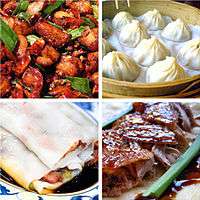
Chinese cuisine is highly diverse, drawing on several millennia of culinary history and geographical variety, in which the most influential are known as the "Eight Major Cuisines", including Sichuan, Cantonese, Jiangsu, Shandong, Fujian, Hunan, Anhui, and Zhejiang cuisines.[522] All of them are featured by the precise skills of shaping, heating, colorway and flavoring.[523] Chinese cuisine is also known for its width of cooking methods and ingredients,[524] as well as food therapy that is emphasized by traditional Chinese medicine.[525] Generally, China's staple food is rice in the south, wheat based breads and noodles in the north. The diet of the common people in pre-modern times was largely grain and simple vegetables, with meat reserved for special occasions. And the bean products, such as tofu and soy milk, remain as a popular source of protein.[526] Pork is now the most popular meat in China, accounting for about three-fourths of the country's total meat consumption.[527] While pork dominates the meat market, there is also the vegetarian Buddhist cuisine and the pork-free Chinese Islamic cuisine. Southern cuisine, due to the area's proximity to the ocean and milder climate, has a wide variety of seafood and vegetables; it differs in many respects from the wheat-based diets across dry northern China. Numerous offshoots of Chinese food, such as Hong Kong cuisine and American Chinese food, have emerged in the nations that play host to the Chinese diaspora.
Sports
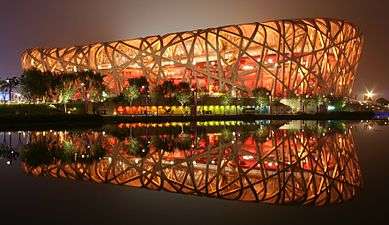
China has one of the oldest sporting cultures in the world. There is evidence that archery (shèjiàn) was practiced during the Western Zhou dynasty. Swordplay (jiànshù) and cuju, a sport loosely related to association football[528] date back to China's early dynasties as well.[529]
Physical fitness is widely emphasized in Chinese culture, with morning exercises such as qigong and t'ai chi ch'uan widely practiced,[530] and commercial gyms and private fitness clubs are gaining popularity across the country.[531] Basketball is currently the most popular spectator sport in China.[532] The Chinese Basketball Association and the American National Basketball Association have a huge following among the people, with native or ethnic Chinese players such as Yao Ming and Yi Jianlian held in high esteem.[533] China's professional football league, now known as Chinese Super League, was established in 1994, it is the largest football market in Asia.[534] Other popular sports in the country include martial arts, table tennis, badminton, swimming and snooker. Board games such as go (known as wéiqí in Chinese), xiangqi, mahjong, and more recently chess, are also played at a professional level.[535] In addition, China is home to a huge number of cyclists, with an estimated 470 million bicycles as of 2012.[395] Many more traditional sports, such as dragon boat racing, Mongolian-style wrestling and horse racing are also popular.[536]
China has participated in the Olympic Games since 1932, although it has only participated as the PRC since 1952. China hosted the 2008 Summer Olympics in Beijing, where its athletes received 51 gold medals – the highest number of gold medals of any participating nation that year.[537] China also won the most medals of any nation at the 2012 Summer Paralympics, with 231 overall, including 95 gold medals.[538][539] In 2011, Shenzhen in Guangdong, China hosted the 2011 Summer Universiade. China hosted the 2013 East Asian Games in Tianjin and the 2014 Summer Youth Olympics in Nanjing; the first country to host both regular and Youth Olympics. Beijing and its nearby city Zhangjiakou of Hebei province will also collaboratively host the 2022 Olympic Winter Games, which will make Beijing the first city in the world to hold both the Summer Olympics and the Winter Olympics.[540]
Notes
- This is due to a classification technicality as Chongqing, being the largest municipality, is composed of the central metropolis, non-connected cities, and the rural area.
- Portuguese (Macau only), English (Hong Kong only).
- In the special administrative regions of Hong Kong and Macau, Traditional Chinese characters are used. The Mongolian script is used in Inner Mongolia and the Tibetan script is used in the Tibetan Autonomous Region, alongside simplified Chinese.
- Ethnic minorities that are recognized officially.
- Xi Jinping holds three concurrent positions: General Secretary of the Communist Party of China (de facto paramount leader), President of the People's Republic of China (head of state), and Chairman of the Central Military Commission (Commander-in-chief) for both state and party.
- According to the official orders of precedence in China (i.e. party comes first), the order of Wang would be inferior to the members of the Standing Committee of Politburo of CPC as he was not appointed to office in the 19th Central Committee.
- The area given is the official United Nations figure for the mainland and excludes Hong Kong, Macau and Taiwan.[3] It also excludes the Trans-Karakoram Tract (5,800 km2 or 2,200 sq mi), Aksai Chin (37,244 km2 or 14,380 sq mi) and other territories in dispute with India. The total area of China is listed as 9,572,900 km2 (3,696,100 sq mi) by the Encyclopædia Britannica.[4] For further information, see Territorial changes of the People's Republic of China.
- This figure was calculated using data from the CIA World Factbook.[6]
- The Hong Kong Dollar is used in Hong Kong and Macau while the Macanese pataca is used in Macau only.
- Motor vehicles and metros drive on the right in mainland China. Hong Kong and Macau use left-hand traffic except several parts of metro lines. The majority of the country's trains drive on the left.
- The total area ranking relative to the United States depends on the measurement of the total areas of China and the United States. See List of countries and dependencies by area for more information.
- This number excludes the disputed 23rd province of Taiwan, which China claims but has no jurisdiction over. See § Administrative divisions
- "[...] Next vnto this, is found the great China, whose kyng is thought to bee the greatest prince in the worlde, and is named Santoa Raia".[19][20]
- "[...] The Very Great Kingdom of China".[21] (Portuguese: ...O Grande Reino da China...).[22]
- Although this is the present meaning of guó, in Old Chinese (when its pronunciation was something like /*qʷˤək/)[28] it meant the walled city of the Chinese and the areas they could control from them.[29]
- Its use is attested from the 6th-century BC Classic of History, which states "Huangtian bestowed the lands and the peoples of the central state to the ancestors" (皇天既付中國民越厥疆土于先王).[30]
- Owing to Qin Shi Huang's earlier policy involving the "burning of books and burying of scholars", the destruction of the confiscated copies at Xianyang was an event similar to the destructions of the Library of Alexandria in the west. Even those texts that did survive had to be painstakingly reconstructed from memory, luck, or forgery.[51] The Old Texts of the Five Classics were said to have been found hidden in a wall at the Kong residence in Qufu. Mei Ze's "rediscovered" edition of the Book of Documents was only shown to be a forgery in the Qing dynasty.
- According to the Encyclopædia Britannica, the total area of the United States, at 9,522,055 km2 (3,676,486 sq mi), is slightly smaller than that of China. Meanwhile, the CIA World Factbook states that China's total area was greater than that of the United States until the coastal waters of the Great Lakes was added to the United States' total area in 1996. From 1989 through 1996, the total area of US was listed as 9,372,610 km2 (3,618,780 sq mi) (land area plus inland water only). The listed total area changed to 9,629,091 km2 (3,717,813 sq mi) in 1997 (with the Great Lakes areas and the coastal waters added), to 9,631,418 km2 (3,718,711 sq mi) in 2004, to 9,631,420 km2 (3,718,710 sq mi) in 2006, and to 9,826,630 km2 (3,794,080 sq mi) in 2007 (territorial waters added).
- China's border with Pakistan and part of its border with India falls in the disputed region of Kashmir. The area under Pakistani administration is claimed by India, while the area under Indian administration is claimed by Pakistan.
- Tsung-Dao Lee,[363] Chen Ning Yang,[363] Daniel C. Tsui,[364] Charles K. Kao,[365] Yuan T. Lee,[366] Tu Youyou[367]
- The national life expectancy at birth rose from about 31 years in 1949 to 75 years in 2008,[471] and infant mortality decreased from 300 per thousand in the 1950s to around 33 per thousand in 2001.[472]
Footnotes
- A variety of academics and institutions have questioned China's official GDP statistics, which they believe to be overstated. See Economy of China#Issues with overclaiming.
- CFPS 2014 surveyed a sample of 13,857 families and 31,665 individuals.[484]:27, note 4 As noted by Katharina Wenzel-Teuber of China Zentrum, German institute for research on religion in China, compared to CFPS 2012, CFPS 2014 asked the Chinese about personal belief in certain conceptions of divinity (i.e. "Buddha", "Tao", "God of the Christians/Jesus", "Heavenly Lord of the Catholics") rather than membership in a religious group.[484]:27 It also included regions, such as those in the west of China, that were excluded in CFPS 2012,[484]:27, note 3 and unregistered Christians.[484]:28 For these reasons, she concludes that CFPS 2014 results are more accurate than 2012 ones.
- CFPS 2017 found that 5.94% of the population declared that they belonged to "other" religious categories besides the five state-sanctioned religions. An additional 0.85% of the population responded that they were "Taoists". Note that the title of "Taoist", in common Chinese usage, is generally attributed only to the Taoist clergy. CFPS 2014 found that a further 0.81% declared that they belonged to the popular salvationist sects, while CFPS 2012 found 2.2%, and CGSS 2006–2010 surveys found an average 3% of the population declaring that they belonged to such religions, while government estimates give higher figures (see the "statistics" section of the present article).
- CFPS 2014 surveyed predominantly people of Han ethnicity. This may have resulted in an underestimation of Muslims. CGSS 2006–2010 surveys found an average 2–3% of the population of China declaring to be Muslim.
References
- "President Xi is making great attempts to 'Sinicize' Marxist-Leninist Thought 'with Chinese characteristics' in the political sphere," states Lutgard Lams, "Examining Strategic Narratives in Chinese Official Discourse under Xi Jinping" Journal of Chinese Political Science (2018) volume 23, pp 387–411 at p. 395.
- "China (People's Republic of) 1982 (rev. 2004)". Constitute. Retrieved 25 August 2019.
- "Demographic Yearbook—Table 3: Population by sex, rate of population increase, surface area and density" (PDF). UN Statistics. 2007. Archived from the original (PDF) on 24 December 2010. Retrieved 31 July 2010.
- "China". Encyclopædia Britannica. Retrieved 16 November 2012.
- "Largest Countries in the World by Area – Worldometers". www.worldometers.info.
- "China". CIA World Factbook. Retrieved 23 November 2013.
- "总人口" (in Chinese). National Bureau of Statistics of China. Retrieved 14 July 2020.
- "Population density (people per sq. km of land area)". IMF. Retrieved 16 May 2015.
- "World Economic Outlook Database, October 2019". IMF.org. International Monetary Fund. Retrieved 30 March 2020.
- "China Economic Update, December 2019 : Cyclical Risks and Structural Imperatives" (PDF). openknowledge.worldbank.org. World Bank. p. 21. Retrieved 3 January 2020.
The Gini coefficient, a measure of overall income inequality, declined to 0.462 in 2015, and has since risen to 0.467 in 2018 (Figure 27). Higher income inequality is partly driven by unequal regional income distribution. The eastern coastal regions have been the driver of China's rapid growth, due to its geographic location and the early introduction of reforms. As a result, the eastern coastal region is now home to 38 percent of the population, and its per capita GDP was 77 percent higher than that of the central, western, and northeastern regions in 2018. This gap widened further in the first three quarters of 2019. This is in part due to a disproportionate slowdown in interior provinces, which are more dependent on commodities and heavy industry. The slowdown has been negatively affected by structural shifts, especially necessary cuts in overcapacity (Figure 28).
- "Human Development Report 2019" (PDF). United Nations Development Programme. 10 December 2019. Retrieved 10 December 2019.
- Lederer, Edith (30 April 2019). "Correction: United Nations-China-Uighurs Story". Archived from the original on 1 May 2019.
- Simon, Scott (23 November 2019). "China's Treatment Of Uighurs". Archived from the original on 16 August 2020.
- Hughes, Roland (8 November 2018). "China Uighurs: All you need to know on Muslim 'crackdown'". Archived from the original on 16 August 2020.
- "Beijing says vocational centers in Xinjiang help combat terrorism". news.cgtn.com. Retrieved 16 August 2020.
- "What's behind Xinjiang vocational training centers?". newsus.cgtn.com. Retrieved 16 August 2020.
- Bilik, Naran (2015), "Reconstructing China beyond Homogeneity", Patriotism in East Asia, Political Theories in East Asian Context, Abingdon: Routledge, p. 105
- "China". Oxford English Dictionary.ISBN 0-19-957315-8
- Eden, Richard (1555), Decades of the New World, p. 230.
- Myers, Henry Allen (1984). Western Views of China and the Far East, Volume 1. Asian Research Service. p. 34.
- Dames, Mansel Longworth, ed. (1918), The Book of Duarte Barbosa, Vol. II, London, p. 211, ISBN 978-81-206-0451-3
- Barbosa, Duarte (1946), Livro em que dá Relação do que Viu e Ouviu no Oriente, Lisbon, archived from the original on 22 October 2008. (in Portuguese)
- "China". The American Heritage Dictionary of the English Language (2000). Boston and New York: Houghton-Mifflin.
- Wade, Geoff. "The Polity of Yelang and the Origin of the Name 'China'". Sino-Platonic Papers, No. 188, May 2009, p. 20.
- Martino, Martin, Novus Atlas Sinensis, Vienna 1655, Preface, p. 2.
- Bodde, Derk (1978). Denis Twitchett; Michael Loewe (eds.). The Cambridge History of China: Volume 1, The Ch'in and Han Empires, 221 BC – AD 220. p. 20. ISBN 978-0-521-24327-8.
- Yule, Henry (1866). Cathay and the Way Thither. pp. 3–7. ISBN 978-81-206-1966-1.
- Baxter-Sagart.
- Wilkinson, Endymion (2000), Chinese History: A Manual, Harvard-Yenching Institute Monograph No. 52, Cambridge: Harvard University Asia Center, p. 132, ISBN 978-0-674-00249-4
- 《尚書》, 梓材. (in Chinese)
- Tang, Xiaoyang; Guo, Sujian; Guo, Baogang (2010). Greater China in an Era of Globalization. Lanham, MD: Rowman & Littlefield Publishers. pp. 52–53. ISBN 978-0-7391-3534-1.
- Ciochon, Russell; Larick, Roy (1 January 2000). "Early Homo erectus Tools in China". Archeology. Retrieved 30 November 2012.
- "The Peking Man World Heritage Site at Zhoukoudian". UNESCO. Archived from the original on 23 June 2016. Retrieved 6 March 2013.
- Shen, G; Gao, X; Gao, B; Granger, De (March 2009). "Age of Zhoukoudian Homo erectus determined with (26)Al/(10)Be burial dating". Nature. 458 (7235): 198–200. Bibcode:2009Natur.458..198S. doi:10.1038/nature07741. ISSN 0028-0836. PMID 19279636.
- Rincon, Paul (14 October 2015). "Fossil teeth place humans in Asia '20,000 years early'". BBC News. Retrieved 14 October 2015.
- Rincon, Paul (17 April 2003). "'Earliest writing' found in China". BBC News. Retrieved 14 January 2020.
- Qiu Xigui (2000). Chinese Writing. English translation of 文字學概論 by Gilbert L. Mattos and Jerry Norman. Early China Special Monograph Series No. 4. Berkeley: The Society for the Study of Early China and the Institute of East Asian Studies, University of California, Berkeley. ISBN 978-1-55729-071-7.
- Tanner, Harold M. (2009). China: A History. Hackett Publishing. pp. 35–36. ISBN 978-0-87220-915-2.
- Xia–Shang–Zhou Chronology Project by People's Republic of China
- "Bronze Age China". National Gallery of Art. Archived from the original on 25 July 2013. Retrieved 11 July 2013.
- China: Five Thousand Years of History and Civilization. City University of HK Press. 2007. p. 25. ISBN 978-962-937-140-1.
- Pletcher, Kenneth (2011). The History of China. Britannica Educational Publishing. p. 35. ISBN 978-1-61530-181-2.
- Fowler, Jeaneane D.; Fowler, Merv (2008). Chinese Religions: Beliefs and Practices. Sussex Academic Press. p. 17. ISBN 978-1-84519-172-6.
- William G. Boltz, Early Chinese Writing, World Archaeology, Vol. 17, No. 3, Early Writing Systems. (Feb. 1986), pp. 420–436 (436).
- David N. Keightley, "Art, Ancestors, and the Origins of Writing in China", Representations, No. 56, Special Issue: The New Erudition. (Autumn, 1996), pp.68–95 [68].
- Hollister, Pam (1996). "Zhengzhou". In Schellinger, Paul E.; Salkin, Robert M. (eds.). International Dictionary of Historic Places: Asia and Oceania. Fitzroy Dearborn Publishers. p. 904. ISBN 978-1-884964-04-6.
- Allan, Keith (2013). The Oxford Handbook of the History of Linguistics. Oxford University Press. p. 4. ISBN 978-0-19-958584-7.
- Sima Qian, Translated by Burton Watson. Records of the Grand Historian: Han Dynasty I, pp. 11–12. ISBN 0-231-08165-0.
- Bodde, Derk. (1986). "The State and Empire of Ch'in", in The Cambridge History of China: Volume I: the Ch'in and Han Empires, 221 B.C. – A.D. 220. Edited by Denis Twitchett and Michael Loewe. Cambridge: Cambridge University Press. ISBN 0-521-24327-0.
- Lewis, Mark Edward (2007). The Early Chinese Empires: Qin and Han. London: Belknap Press. ISBN 978-0-674-02477-9.
- Cotterell, Arthur (2011), The Imperial Capitals of China, Pimlico, pp. 35–36
- "Dahlman, Carl J; Aubert, Jean-Eric. China and the Knowledge Economy: Seizing the 21st century". World Bank Publications via Eric.ed.gov. Retrieved 22 October 2012.
- Goucher, Candice; Walton, Linda (2013). World History: Journeys from Past to Present – Volume 1: From Human Origins to 1500 CE. Routledge. p. 108. ISBN 978-1-135-08822-4.
- Whiting, Marvin C. (2002). Imperial Chinese Military History. iUniverse. p. 214
- Ki-Baik Lee (1984). A new history of Korea. Harvard University Press. ISBN 978-0-674-61576-2. p.47.
- David Andrew Graff (2002). Medieval Chinese warfare, 300–900. Routledge. ISBN 0-415-23955-9. p.13.
- Adshead, S. A. M. (2004). T'ang China: The Rise of the East in World History. New York: Palgrave Macmillan. p. 54
- Nishijima, Sadao (1986), "The Economic and Social History of Former Han", in Twitchett, Denis; Loewe, Michael (eds.), Cambridge History of China: Volume I: the Ch'in and Han Empires, 221 B.C. – A.D. 220, Cambridge: Cambridge University Press, pp. 545–607, ISBN 978-0-521-24327-8
- Bowman, John S. (2000). Columbia Chronologies of Asian History and Culture. New York: Columbia University Press. pp. 104–105.
- City University of HK Press (2007). China: Five Thousand Years of History and Civilization. ISBN 962-937-140-5. p.71
- Paludan, Ann (1998). Chronicle of the Chinese Emperors. London: Thames & Hudson. ISBN 0-500-05090-2. p. 136.
- Essentials of Neo-Confucianism: Eight Major Philosophers of the Song and Ming Periods. Greenwood Publishing Group. 1999. p. 3. ISBN 978-0-313-26449-8.
- "Northern Song dynasty (960–1127)". Metropolitan Museum of Art. Retrieved 27 November 2013.
- 从汝窑、修内司窑和郊坛窑的技术传承看宋代瓷业的发展. wanfangdata.com.cn. 15 February 2011. Retrieved 15 August 2015.
- Daily Life in China on the Eve of the Mongol Invasion, 1250–1276. Stanford University Press. 1962. p. 22. ISBN 978-0-8047-0720-6.
- Ping-ti Ho. "An Estimate of the Total Population of Sung-Chin China", in Études Song, Series 1, No 1, (1970). pp. 33–53.
- Rice, Xan (25 July 2010). "Chinese archaeologists' African quest for sunken ship of Ming admiral". The Guardian. Retrieved 16 January 2020.
- "Wang Yangming (1472—1529)". Internet Encyclopedia of Philosophy. Archived from the original on 9 November 2013. Retrieved 9 December 2013.
- 论明末士人阶层与资本主义萌芽的关系. docin.com. 8 April 2012. Retrieved 2 September 2015.
- Gomes, Luis. "HISTÓRIA – 500 ANOS DA CHEGADA DE JORGE ÁLVARES". nenotavaiconta.
- Boxer, Charles. "ALGUNS ASPECTOS DA INFLUÊNCIA PORTUGUESA NO JAPÃO, 1542-1640".
- Viegas, João. "Prisioneiros do Império Celeste: O desastre da primeira embaixada portuguesa na China (1517-1524)". Revista Macau.
- "Integração de Hong Kong e Macau na China". Porto Editora. 2003–2020.
- Saraiva, Luis. "History Of Mathematical Sciences: Portugal And East Asia Iv – Europe And China".
- Cooper, Michael. "Rodrigues the Interpreter: An Early Jesuit in Japan and China".
- Jami, Engelfriet, Blue, Catherine , Peter , Blue. "Statecraft and Intellectual Renewal in Late Ming China: The Cross-Cultural".CS1 maint: multiple names: authors list (link)
- Roy,Lorge, Kaushik , Peter. "Chinese and Indian Warfare - From the Classical Age to 1870".
- Swope, Kenneth. "The Military Collapse of China's Ming Dynasty, 1618-44".
- Jingyao, Yanyan, Sun , Deng. "On the Story of the Jesuits' Action in the Southern Ming Dynasty".
- Givon, Yuval. "A Tale of Dynastic Change in China: The Ming-Qing Transition through Athanasius Kircher SJ's China illustrata (1667)" (PDF).
- John M. Roberts (1997). A Short History of the World. Oxford University Press. p. 272. ISBN 0-19-511504-X.
- The Cambridge History of China: Volume 10, Part 1, by John K. Fairbank, p37
- 中国通史·明清史. 九州出版社. 2010. pp. 104–112. ISBN 978-7-5108-0062-7.
- 中华通史·第十卷. 花城出版社. 1996. p. 71. ISBN 978-7-5360-2320-8.
- Ainslie Thomas Embree, Carol Gluck (1997). Asia in Western and World History: A Guide for Teaching. M.E. Sharpe. p.597. ISBN 1-56324-265-6.
- "Sino-Japanese War (1894–95)". Encyclopædia Britannica. Retrieved 12 November 2012.
- "Dimensions of need – People and populations at risk". Food and Agriculture Organization of the United Nations (FAO). 1995. Retrieved 3 July 2013.
- Eileen Tamura (1997). China: Understanding Its Past. Volume 1. University of Hawaii Press. ISBN 0-8248-1923-3. p.146.
- Stephen Haw, (2006). Beijing: A Concise History. Taylor & Francis, ISBN 0-415-39906-8. p.143.
- Bruce Elleman (2001). Modern Chinese Warfare. Routledge. ISBN 0-415-21474-2. p.149.
- Graham Hutchings (2003). Modern China: A Guide to a Century of Change. Harvard University Press. ISBN 0-674-01240-2. p.459.
- Peter Zarrow (2005). China in War and Revolution, 1895–1949. Routledge. ISBN 0-415-36447-7. p.230.
- M. Leutner (2002). The Chinese Revolution in the 1920s: Between Triumph and Disaster. Routledge. ISBN 0-7007-1690-4. p.129.
- Hung-Mao Tien (1972). Government and Politics in Kuomintang China, 1927–1937 (Volume 53). Stanford University Press. ISBN 0-8047-0812-6. pp. 60–72.
- Suisheng Zhao (2000). China and Democracy: Reconsidering the Prospects for a Democratic China. Routledge. ISBN 0-415-92694-7. p.43.
- David Ernest Apter, Tony Saich (1994). Revolutionary Discourse in Mao's Republic. Harvard University Press. ISBN 0-674-76780-2. p.198.
- "Nuclear Power: The End of the War Against Japan". BBC — History. Retrieved 14 July 2013.
- "Judgement: International Military Tribunal for the Far East". Chapter VIII: Conventional War Crimes (Atrocities). November 1948. Retrieved 4 February 2013.
- Doenecke, Justus D.; Stoler, Mark A. (2005). Debating Franklin D. Roosevelt's Foreign Policies, 1933–1945. Rowman & Littlefield. ISBN 978-0-8476-9416-7.
- "The Moscow Declaration on general security". Yearbook of the United Nations 1946–1947. Lake Success, NY: United Nations. 1947. p. 3. OCLC 243471225. Retrieved 25 April 2015.
- "Declaration by United Nations". United Nations. Retrieved 20 June 2015.
- Hoopes, Townsend, and Douglas Brinkley. FDR and the Creation of the U.N. (Yale University Press, 1997)
- Gaddis, John Lewis (1972). The United States and the Origins of the Cold War, 1941–1947. Columbia University Press. pp. 24–25. ISBN 978-0-231-12239-9.CS1 maint: ref=harv (link)
- Tien, Hung-mao (1991). "Constitutional Reform and the Future of the Republic of China". In Feldman, Harvey (ed.). Constitutional Reform and the Future of the Republic of China. M.E. Sharpe. p. 3. ISBN 978-0-87332-880-7.
- "The Chinese people have stood up". UCLA Center for East Asian Studies. Archived from the original on 18 February 2009. Retrieved 16 April 2006.
- Peaslee, Amos J. (1956), "Data Regarding the 'People's Republic of China'", Constitutions of Nations, Vol. I, 2nd ed., Dordrecht: Springer, p. 533, ISBN 978-94-017-7125-2
- Chaurasia, Radhey Shyam (2004), History of Modern China, New Delhi: Atlantic, p. 1, ISBN 978-81-269-0315-3
- Ben Westcott; Lily Lee (30 September 2019). "They were born at the start of Communist China. 70 years later, their country is unrecognizable". CNN.
- "Red Capture of Hainan Island". The Tuscaloosa News. 9 May 1950. Retrieved 20 July 2013.
- "The Tibetans" (PDF). University of Southern California. Archived from the original (PDF) on 16 October 2013. Retrieved 20 July 2013.
- John W. Garver (1997). The Sino-American alliance: Nationalist China and American Cold War strategy in Asia. M.E. Sharpe. p. 169. ISBN 978-0-7656-0025-7. Retrieved 20 July 2013.
- Busky, Donald F. (2002). Communism in History and Theory. Greenwood Publishing Group. p.11.
- "A Country Study: China". www.loc.gov. Retrieved 3 October 2017.
- Madelyn Holmes (2008). Students and teachers of the new China: thirteen interviews. McFarland. p. 185. ISBN 978-0-7864-3288-2. Retrieved 7 November 2011.
- "A hunger for the truth: A new book, banned on the mainland, is becoming the definitive account of the Great Famine.", chinaelections.org, 7 July 2008 Archived 10 February 2012 at the Wayback Machine
- Mirsky, Jonathan (9 December 2012). "Unnatural Disaster". The New York Times. Retrieved 7 December 2012.
- Holmes, Leslie. Communism: A Very Short Introduction (Oxford University Press 2009). ISBN 978-0-19-955154-5. p. 32 "Most estimates of the number of Chinese dead are in the range of 15 to 30 million."
- Michael Y.M. Kao. "Taiwan's and Beijing's Campaigns for Unification" in Harvey Feldman and Michael Y. M. Kao (eds., 1988): Taiwan in a Time of Transition. New York: Paragon House. p.188.
- Hart-Landsberg, Martin; and Burkett, Paul. "China and Socialism: Market Reforms and Class Struggle". Monthly Review. Retrieved 30 October 2008.
- Harding, Harry (December 1990). "The Impact of Tiananmen on China's Foreign Policy". National Bureau of Asian Research. Archived from the original on 4 April 2014. Retrieved 28 November 2013.
- "Nation bucks trend of global poverty". China Daily. 11 July 2003. Archived from the original on 14 August 2011. Retrieved 10 July 2013.
- "China's Average Economic Growth in 90s Ranked 1st in World". People's Daily. 1 March 2000. Retrieved 10 July 2013.
- Carter, Shan; Cox, Amanda; Burgess, Joe; Aigner, Erin (26 August 2007). "China's Environmental Crisis". The New York Times. Retrieved 16 May 2012.
- Griffiths, Daniel (16 April 2004). "China worried over pace of growth". BBC News. Retrieved 16 April 2006.
- China: Migrants, Students, Taiwan. Migration News. January 2006.
- Cody, Edward (28 January 2006). "In Face of Rural Unrest, China Rolls Out Reforms". The Washington Post. ISSN 0190-8286. Retrieved 18 January 2020.
- "China frees up bank lending rates". BBC News. 19 July 2013. Retrieved 19 July 2013.
- Evans-Pritchard, Ambrose (23 July 2013). "China eyes fresh stimulus as economy stalls, sets 7pc growth floor". The Daily Telegraph. Retrieved 25 July 2013.
- Davies, Gavyn (25 November 2012). "The decade of Xi Jinping". Financial Times. Retrieved 27 November 2012.
- "China orders government debt audit". BBC News. 29 July 2013. Retrieved 29 July 2013.
- Joong, Shik Kang; Wei, Liao (May 2016). "Chinese Imports: What's Behind the Slowdown?" (PDF). International Monetary Fund. Retrieved 28 May 2018.
- Yglesias, Matthew (15 November 2013). "China ends one child policy". Slate. Archived from the original on 16 November 2013. Retrieved 16 November 2013.
- "China's president boosts anti-corruption crackdown after nabbing 1.5M". NBC News.
- "Coronavirus Disease (COVID-19) - events as they happen". www.who.int. WHO. Retrieved 9 March 2020.
- "Coronavirus COVID-19 Global Cases by Johns Hopkins CSSE". Johns Hopkins University. Retrieved 9 March 2020.
- Beck, Hylke E.; Zimmermann, Niklaus E.; McVicar, Tim R.; Vergopolan, Noemi; Berg, Alexis; Wood, Eric F. (30 October 2018). "Present and future Köppen-Geiger climate classification maps at 1-km resolution". Scientific Data. 5: 180214. Bibcode:2018NatSD...580214B. doi:10.1038/sdata.2018.214. PMC 6207062. PMID 30375988.
- "Nepal and China agree on Mount Everest's height". BBC News. 8 April 2010. Retrieved 18 January 2020.
- "Lowest Places on Earth". National Park Service. 28 February 2015. Retrieved 2 December 2013.
- Regional Climate Studies of China. Springer. 2008. p. 1. Bibcode:2008rcsc.book.....F. ISBN 978-3-540-79242-0.
- Waghorn, Terry (7 March 2011). "Fighting Desertification". Forbes. Retrieved 21 January 2020.
- "Beijing hit by eighth sandstorm". BBC News. 17 April 2006. Retrieved 21 January 2020.
- Coonan, Clifford (9 November 2007). "The gathering sandstorm: Encroaching desert, missing water". The Independent. Archived from the original on 24 April 2008. Retrieved 23 July 2014.
- Reilly, Michael (24 November 2008). "Himalaya glaciers melting much faster". NBC News. Retrieved 21 September 2011.
- "Countries by commodity". FAOSTAT. Retrieved 16 January 2020.
- Williams, Jann (10 December 2009). "Biodiversity Theme Report". Environment.gov.au. Archived from the original on 11 August 2011. Retrieved 27 April 2010.
- Countries with the Highest Biological Diversity Archived 26 March 2013 at the Wayback Machine. Mongabay.com. 2004 data. Retrieved 24 April 2013.
- "Country Profiles – China". Convention on Biological Diversity. Retrieved 9 December 2012.
- "[English translation: China Biodiversity Conservation Strategy and Action Plan. Years 2011–2030]" (PDF). Convention on Biological Diversity. Retrieved 9 December 2012.
- IUCN Initiatives – Mammals – Analysis of Data – Geographic Patterns 2012 Archived 12 May 2013 at the Wayback Machine. IUCN. Retrieved 24 April 2013. Data does not include species in Taiwan.
- Countries with the most bird species Archived 16 February 2013 at the Wayback Machine. Mongabay.com. 2004 data. Retrieved 24 April 2013.
- Countries with the most reptile species. Mongabay.com. 2004 data. Retrieved 24 April 2013.
- IUCN Initiatives – Amphibians – Analysis of Data – Geographic Patterns 2012 Archived 12 May 2013 at the Wayback Machine. IUCN. Retrieved 24 April 2013. Data does not include species in Taiwan.
- Top 20 countries with most endangered species IUCN Red List Archived 24 April 2013 at the Wayback Machine. 5 March 2010. Retrieved 24 April 2013.
- "Nature Reserves". China Internet Information Center. Archived from the original on 15 November 2010. Retrieved 2 December 2013.
- "Chinese River Dolphin Declared Extinct". National Geographic Society. 17 December 2013. Retrieved 17 October 2019.
- Countries with the most vascular plant species Archived 12 January 2014 at the Wayback Machine. Mongabay.com. 2004 data. Retrieved 24 April 2013.
- China (3 ed.). Rough Guides. 2003. p. 1213. ISBN 978-1-84353-019-0.
- Conservation Biology: Voices from the Tropics. John Wiley & Sons. 2013. p. 208. ISBN 978-1-118-67981-4.
- Liu, Ji-Kai (2007). "Secondary metabolites from higher fungi in China and their biological activity". Drug Discoveries & Therapeutics. 1 (2): 94. Archived from the original on 7 December 2013.
- Ma, Xiaoying; Ortalano, Leonard (2000). Environmental Regulation in China. Rowman & Littlefield Publishers. p. 1. ISBN 978-0-8476-9399-3.
- "China acknowledges 'cancer villages'". BBC News. 22 February 2013. Retrieved 23 February 2013.
- Soekov, Kimberley (28 October 2012). "Riot police and protesters clash over China chemical plant". BBC News. Retrieved 18 January 2020.
- "Is air quality in China a social problem?". ChinaPower Project. 15 February 2016. Retrieved 26 March 2020.
- "Ambient air pollution: A global assessment of exposure and burden of disease". World Health Organization. Retrieved 28 April 2018.
- Chestney, Nina (10 June 2013). "Global carbon emissions hit record high in 2012". Reuters. Retrieved 3 November 2013.
- "China says progress made on water pollution, but battle remains". South China Morning Post. 1 June 2018. Retrieved 26 March 2020.
- "China's decade plan for water" Archived 30 October 2011 at the Wayback Machine. The Earth Institute. Columbia University. 24 October 2011. Retrieved 23 November 2011.
- Friedman, Lisa (25 March 2010). "China Leads Major Countries With $34.6 Billion Invested in Clean Technology". The New York Times. Retrieved 27 April 2010.
- Black, Richard (26 March 2010). "China steams ahead on clean energy". BBC News. Retrieved 27 April 2010.
- Perkowski, Jack (27 July 2012). "China Leads The World in Renewable Energy Investment". Forbes. Retrieved 5 December 2012.
- Bradsher, Keith (30 January 2010). "China leads global race to make clean energy". New York Times.
- "China's big push for renewable energy". Scientific American. 4 August 2008. Retrieved 24 September 2011.
- "China to plow $361 billion into renewable fuel by 2020". Reuters. Retrieved 28 May 2018.
- Mishra, D. P. (1 November 2010). "China tops the world in clean energy production". Ecosensorium. Retrieved 24 September 2011.
- "2015 Key World Energy Statistics" (PDF). report. International Energy Agency (IEA). Retrieved 1 June 2016.
- 2016 Snapshot of Global Photovoltaic Markets, p.7, International Energy Agency, 2017
- "AWEA 2016 Fourth Quarter Market Report". AWEA. American Wind Energy Association. Archived from the original on 11 February 2017. Retrieved 9 February 2017.
- Amitendu, Palit (2012). China-India Economics: Challenges, Competition and Collaboration. Routledge. p. 4. ISBN 978-1-136-62162-8.
- "Geography". China Internet Information Center. Archived from the original on 13 September 2015. Retrieved 31 May 2015.
- "United States". Encyclopædia Britannica. Retrieved 25 March 2008.
- Rosenberg, Matt. "Which country borders the most other countries?". About.com. Archived from the original on 19 October 2013. Retrieved 5 December 2013.
- "Constitution of the People's Republic of China". www.constituteproject.org. Retrieved 17 January 2020.
- Unger, Jonathan; Chan, Anita (January 1995). "China, Corporatism, and the East Asian Model". The Australian Journal of Chinese Affairs. 33 (33): 29–53. doi:10.2307/2950087. JSTOR 2950087.
- "Freedom in the World 2011: China". Freedom House. 2011. Retrieved 19 June 2013.
- "Consultative Democracy, People's Democracy". www.chinatoday.com.cn. Retrieved 26 March 2020.
- "Xi reiterates adherence to socialism with Chinese characteristics". Xinhua News Agency. 5 January 2013. Archived from the original on 1 February 2018. Retrieved 14 January 2020.
- Lutgard Lams, "Examining Strategic Narratives in Chinese Official Discourse under Xi Jinping" Journal of Chinese Political Science (2018) volume 23, pp 387–411 at p. 395.
- Wei, Changhao (11 March 2018). "Annotated Translation: 2018 Amendment to the P.R.C. Constitution (Version 2.0)". NPC Observer. Retrieved 22 August 2019.
- Hernández, Javier C. (25 October 2017). "China's 'Chairman of Everything': Behind Xi Jinping's Many Titles". The New York Times. ISSN 0362-4331. Retrieved 14 January 2020.
Mr. Xi's most important title is general secretary, the most powerful position in the Communist Party. In China's one-party system, this ranking gives him virtually unchecked authority over the government.
- Bajoria, Jayshree (12 October 2017). "The Communist Party of China". Council on Foreign Relations. Archived from the original on 11 May 2010. Retrieved 27 April 2010.
- "Democratic Parties". People's Daily. Retrieved 8 December 2013.
- "How China is Ruled: National People's Congress". BBC News. Retrieved 14 July 2009.
- Shirk, Susan (13 November 2012). "China's Next Leaders: A Guide to What's at Stake". China File. Retrieved 31 May 2015.
- Moore, Malcolm (15 November 2012). "Xi Jinping crowned new leader of China Communist Party". The Daily Telegraph. Retrieved 15 November 2012.
- "Beijingers Get Greater Poll Choices". China Daily. 8 December 2003. Archived from the original on 3 June 2004. Retrieved 18 February 2007.
- Lohmar, Bryan; and Somwaru, Agapi; Does China's Land-Tenure System Discourage Structural Adjustment?. 1 May 2006. USDA Economic Research Service. Retrieved 3 May 2006.
- "Xi Jinping at China congress calls on party to tighten its grip on the country". The Washington Post. 18 October 2017. Retrieved 3 March 2020.
- "China sounds alarm over fast growing gap between rich and poor". Associated Press. 11 May 2002. Archived from the original on 10 June 2014. Retrieved 1 February 2013.
- "A Point of View: Is China more legitimate than the West?". BBC News. 2 November 2012. Retrieved 14 January 2020.
- Chang, Eddy (22 August 2004). Perseverance will pay off at the UN Archived 6 August 2007 at the Wayback Machine, The Taipei Times.
- "China says communication with other developing countries at Copenhagen summit transparent". People's Daily. 21 December 2009. Retrieved 31 January 2019.
- "Bric summit ends in China with plea for more influence". BBC News. 14 April 2011. Retrieved 24 October 2011.
- "Taiwan's Ma to stopover in US: report". Agence France-Presse. 12 January 2010. Archived from the original on 9 September 2015.
- Macartney, Jane (1 February 2010). "China says US arms sales to Taiwan could threaten wider relations". The Times. Retrieved 18 January 2020.
- Keith, Ronald C. China from the inside out – fitting the People's republic into the world. PlutoPress. pp. 135–136.
- "An Authoritarian Axis Rising?". The Diplomat. 29 June 2012. Archived from the original on 16 December 2013.
- "China, Russia launch largest ever joint military exercise". Deutsche Welle. 5 July 2013. Retrieved 5 July 2013.
- "Energy to dominate Russia President Putin's China visit". BBC News. 5 June 2012. Retrieved 16 January 2020.
- Gladstone, Rick (19 July 2012). "Friction at the U.N. as Russia and China Veto Another Resolution on Syria Sanctions". The New York Times. ISSN 0362-4331. Retrieved 15 November 2012.
- "Xi Jinping: Russia-China ties 'guarantee world peace'". BBC News. 23 March 2013. Retrieved 23 March 2013.
- Monaghan, Angela (10 January 2014). "China surpasses US as world's largest trading nation". The Guardian. ISSN 0261-3077. Retrieved 4 December 2019.
- Desjardins, Jeff (27 April 2016). "Four Maps Showing China's Rising Dominance in Trade". Visual Capitalist. Retrieved 4 December 2019.
- Dillon, Dana; and Tkacik, John, Jr.; China's Quest for Asia. Policy Review. December 2005 and January 2006. Issue No. 134. Retrieved 22 April 2006.
- Smith, Matt (10 October 2000). "Clinton signs China trade bill". CNN. Archived from the original on 5 May 2009. Retrieved 16 January 2020.
- "US trade gap up on China imports". BBC News. 14 October 2010. Retrieved 18 January 2020.
- "China resists Obama yuan overture". BBC News. 13 April 2010. Retrieved 16 January 2020.
- Palmer, Doug (24 September 2012). "Obama should call China a currency manipulator: Romney aide". Reuters. Retrieved 6 October 2012.
- "US says China not a currency manipulator". BBC News. 27 November 2012. Retrieved 28 November 2012.
- McLaughlin, Abraham (30 March 2005). "A rising China counters US clout in Africa". Christian Science Monitor. ISSN 0882-7729. Archived from the original on 16 August 2007. Retrieved 18 January 2020.
- Lyman, Princeton (21 July 2005). "China's Rising Role in Africa". Council on Foreign Relations. Archived from the original on 15 July 2007. Retrieved 26 June 2007.
- Politzer, Malia (6 August 2008). "China and Africa: Stronger Economic Ties Mean More Migration". Migration Policy Institute. Retrieved 26 January 2013.
- "China-Africa trade likely to hit record high". China Daily. 28 December 2012. Archived from the original on 31 December 2012. Retrieved 29 January 2013.
- Se, Young Lee; Woo, Ryan (25 October 2019). "China says willing to increase agricultural, industrial goods imports from Brazil". Reuters. Retrieved 16 January 2020.
- "China-Argentina ties at a glance". China Daily. 2 December 2018. Retrieved 16 January 2020.
- "Chinese Civil War". Cultural-China.com. Archived from the original on 12 September 2013. Retrieved 16 June 2013.
To this day, since no armistice or peace treaty has ever been signed, there is controversy as to whether the Civil War has legally ended.
- "Groundless to view China as expansionist, says Beijing after PM Modi's Ladakh visit". India Today. Retrieved 13 August 2020.
- Fravel, M. Taylor (1 October 2005). "Regime Insecurity and International Cooperation: Explaining China's Compromises in Territorial Disputes". International Security. 30 (2): 46–83. doi:10.1162/016228805775124534. ISSN 0162-2889.
- Fravel, M. Taylor (2008). Strong Borders, Secure Nation: Cooperation and Conflict in China's Territorial Disputes. Princeton University Press. ISBN 9780691136097.
- "China denies preparing war over South China Sea shoal". BBC News. 12 May 2012. Retrieved 16 January 2020.
- "How uninhabited islands soured China-Japan ties". BBC News. 27 November 2013. Retrieved 16 January 2020.
- Sorman, Guy (2008). Empire of Lies: The Truth About China in the Twenty-First Century. pp. 46, 152. ISBN 978-1-59403-284-4.
- "World Report 2009: China". Human Rights Watch. Retrieved 14 July 2009.
- "China Requires Internet Users to Register Names". AP via My Way News. 28 December 2012. Retrieved 29 December 2012.
- Bradsher, Keith (28 December 2012). "China Toughens Its Restrictions on Use of the Internet". The New York Times. ISSN 0362-4331. Retrieved 25 January 2020.
- King, Gary; Pan, Jennifer; Roberts, Margaret E. (May 2013). "How Censorship in China Allows Government Criticism but Silences Collective Expression" (PDF). American Political Science Review. 107 (2): 326–343. doi:10.1017/S0003055413000014. Retrieved 6 March 2015.
Our central theoretical finding is that, contrary to much research and commentary, the purpose of the censorship program is not to suppress criticism of the state or the Communist Party.
- Raphael, René; Ling, Xi (23 January 2019). "Discipline and Punish: The Birth of China's Social-Credit System". The Nation. Retrieved 14 January 2020.
- "China's behavior monitoring system bars some from travel, purchasing property". CBS News. 24 April 2018. Retrieved 25 January 2020.
- Kobie, Nicole (21 January 2019). "The complicated truth about China's social credit system". Wired. Retrieved 7 June 2019.
- Tang, Didi (9 January 2014). "Forced abortion highlights abuses in China policy". Associated Press. Archived from the original on 7 November 2014. Retrieved 16 January 2020.
- "China bans religious activities in Xinjiang". Financial Times. 2 August 2012. Retrieved 28 August 2012.
- Fan, Maureen; Cha, Ariana Eunjung (24 December 2008). "China's Capital Cases Still Secret, Arbitrary". The Washington Post. ISSN 0190-8286. Retrieved 16 August 2010.
- Millard, Robin (27 March 2012). "Amnesty sees hope in China on death penalty". Agence France-Presse. Retrieved 31 May 2015.
- Christian Göbel and Lynette H. Ong, "Social unrest in China." Long Briefing, Europe China Research and Academic Network (ECRAN) (2012) p 18.
- Faison, Seth (27 April 1999). "In Beijing: A Roar of Silent Protesters". The New York Times. Retrieved 19 January 2020.
- Amnesty International (December 2013). Changing the soup but not the medicine: Abolishing re-education through labor in China (PDF). Lon. Archived from the original (PDF) on 1 February 2016.
- Spiegel, Mickey (2002). Dangerous Meditation: China's Campaign Against Falungong. Human Rights Watch. ISBN 978-1-56432-269-2.CS1 maint: ref=harv (link)
- https://www.bbc.com/news/world-asia-15617026
- https://foreignpolicy.com/2020/07/15/uighur-genocide-xinjiang-china-surveillance-sterilization/
- Hatton, Celia (27 June 2013). "China 'moves two million Tibetans'". BBC News. Retrieved 27 June 2013.
- "Fresh unrest hits China's Xinjiang". BBC News. 29 June 2013. Retrieved 29 June 2013.
- Graham-Harrison, Emma; Garside, Juliette (24 November 2019). "'Allow no escapes': leak exposes reality of China's vast prison camp network". The Guardian. ISSN 0261-3077. Retrieved 18 January 2020.
- "2019 Report on International Religious Freedom: China - Xinjiang". 2019. Archived from the original on 15 August 2020.
- Kuo, Lily (11 January 2019). "'If you enter a camp, you never come out': inside China's war on Islam". The Guardian. ISSN 0261-3077. Retrieved 18 January 2020.
- Denyer, Simon (28 February 2018). "China detains relatives of U.S. reporters in apparent punishment for Xinjiang coverage". The Washington Post. Retrieved 4 March 2018.
- "China". Global Slavery Index. 2016. Archived from the original on 6 July 2016. Retrieved 13 March 2018.
- Pejan, Ramin. "Laogai: "Reform Through Labor" in China". Washington College of Law. Archived from the original on 25 June 2002. Retrieved 19 January 2020.
- https://chinatribunal.com
- Davey, Melissa (5 February 2019). "Call for retraction of 400 scientific papers amid fears organs came from Chinese prisoners". The Guardian. ISSN 0261-3077. Retrieved 16 October 2019.
- "The new generals in charge of China's guns". BBC News. 14 November 2012. Retrieved 10 December 2012.
- Perlo-Freeman, Sam (March 2014). "Mar. 2014: Deciphering China's latest defence budget figures". SIPRI. Archived from the original on 9 February 2015. Retrieved 9 February 2015.
- Annual Report To Congress – Military Power of the People's Republic of China 2009 (PDF). Defenselink.mil. Retrieved 27 November 2011.
- "World Bank World Development Indicators". World Bank. Retrieved 8 December 2014.
- Kollewe, Justin McCurry Julia (14 February 2011). "China overtakes Japan as world's second-largest economy". The Guardian. ISSN 0261-3077. Retrieved 8 July 2019.
- "China's economy grew 6.6 percent in 2018, officials say". chinaplus.cri.cn. Retrieved 18 February 2019.
- "GDP PPP (World Bank)". World Bank. 2018. Retrieved 18 February 2019.
- "GDP (current US$) – China". World Bank. Retrieved 18 February 2019.
- "GDP growth (annual %) – China". World Bank. Retrieved 25 May 2018.
- White, Garry (10 February 2013). "China trade now bigger than US". The Daily Telegraph. Retrieved 15 February 2013.
- Roach, Stephen S. (2 September 2016). "Why China is central to global growth". World Economic Forum. Retrieved 28 November 2019.
- Desjardins, Jeff (15 March 2019). "The Economies Adding the Most to Global Growth in 2019". Visual Capitalist. Retrieved 28 November 2019.
- Dahlman, Carl J; Aubert, Jean-Eric. "China and the Knowledge Economy: Seizing the 21st Century. WBI Development Studies. World Bank Publications". Institute of Education Sciences. Retrieved 26 July 2014.
- "Angus Maddison. Chinese Economic Performance in the Long Run. Development Centre Studies. Accessed 2007. p.29" (PDF). Retrieved 15 September 2017.
- "Top 10 Largest Stock Exchanges in the World By Market Capitalization". ValueWalk. 19 February 2019. Retrieved 28 November 2019.
- Marsh, Peter (13 March 2011). "China noses ahead as top goods producer". Financial Times. Retrieved 18 January 2020.
- Levinson, Marc (21 February 2018). "U.S. Manufacturing in International Perspective" (PDF). Federation of American Scientists.
- "Report – S&E Indicators 2018 | NSF – National Science Foundation". www.nsf.gov. Retrieved 8 July 2019.
- Shane, Daniel (23 January 2019). "China will overtake the US as the world's biggest retail market this year". CNN. Retrieved 18 February 2019.
- Fan, Ziyang; Backaler, Joel (17 September 2018). "Five trends shaping the future of e-commerce in China". World Economic Forum. Retrieved 18 February 2019.
- Lipsman, Andrew (27 June 2019). "Global Ecommerce 2019". eMarketer. Retrieved 28 November 2019.
- Huang, Echo; Huang, Echo. "China buys one out of every two electric vehicles sold globally". Quartz. Retrieved 18 February 2019.
- "China Installs 44.3 Gigawatts Of Solar In 2018". CleanTechnica. 23 January 2019. Retrieved 18 February 2019.
- "Global PV capacity is expected to reach 969GW by 2025". Power Technology | Energy News and Market Analysis. 21 December 2017. Retrieved 18 February 2019.
- Kurtenbach, Elaine (27 February 2019). "Billionaire list shows $1T hit from '18 market meltdown". AP News. Retrieved 17 February 2020.
- "China Is Set to Keep Minting New Millionaires Faster Than U.S." www.bloomberg.com. Retrieved 19 February 2019.
- "GDP PPP (World Bank)". worldbank.org. World Bank. 2018. Retrieved 18 February 2019.
- King, Stephen (2 February 2016). "China's path to tackling regional inequality". Financial Times.
- India, Press Trust of (13 October 2017). "China lifting 800 million people out of poverty is historic:World Bank". Business Standard India. Retrieved 22 February 2019.
- "China's Approach to Reduce Poverty: Taking Targeted Measures to Lift People out of Poverty" (PDF). United Nations. Retrieved 21 February 2019.
- "Data | The World Bank". datatopics.worldbank.org. Retrieved 22 February 2019.
- "China brings nearly 13 mln people out of poverty in 2017". Xinhua News Agency. 1 February 2018. Retrieved 22 February 2019.
- Li, Yingqi (5 March 2018). "China's extreme poverty rate to fall below 1% in 2018: World Bank". People's Daily. Retrieved 22 February 2019.
- Khan, Yusuf (22 October 2019). "China has overtaken the US to have the most wealthy people in the world | Markets Insider". Business Insider. Retrieved 12 November 2019.
- "China is now home to more wealthy people than the US". South China Morning Post. 23 October 2019. Retrieved 21 November 2019.
- Dawkins, David (21 October 2019). "China Overtakes U.S. In Global Household Wealth Rankings 'Despite' Trade Tensions – Report". Forbes. Retrieved 12 November 2019.
- "Shanghai's GDP grows 8.2% in 2011". China Daily. 20 January 2012. Retrieved 15 April 2012.
- "China is already a market economy—Long Yongtu, Secretary General of Boao Forum for Asia". EastDay.com. 2008. Archived from the original on 9 September 2009. Retrieved 14 July 2009.
- "Communism Is Dead, But State Capitalism Thrives". Vahan Janjigian. Forbes. 22 March 2010. Retrieved 11 July 2013.
- "The Winners And Losers In Chinese Capitalism". Gady Epstein. Forbes. 31 August 2010. Retrieved 11 July 2013.
- John Lee. "Putting Democracy in China on Hold". The Center for Independent Studies. 26 July 2008. Retrieved 16 July 2013.
- "China has socialist market economy in place". People's Daily. 13 July 2005. Retrieved 27 April 2010.
- "China Is a Private-Sector Economy". Bloomberg Businessweek. 22 August 2005. Archived from the original on 13 February 2008. Retrieved 27 April 2010.
- "Microsoft Word – China2bandes.doc" (PDF). OECD. Archived from the original (PDF) on 2015. Retrieved 27 April 2010.
- "Data shows strength of China's private enterprises". www.ecns.cn. Retrieved 19 February 2019.
- "China's economy slows but data hints at rebound". BBC News. 18 October 2012. Retrieved 20 January 2020.
- "China Loses Control of Its Frankenstein Economy". Bloomberg L.P. 24 June 2013. Retrieved 25 June 2013.
- Foley, John (15 July 2013). "The lowdown on China's slowdown: It's not all bad". Fortune. Retrieved 16 July 2013.
- "GDP (current US$) – China, Germany, United Kingdom, France, Italy". World Bank. Retrieved 18 February 2019.
- "China's Economic Outlook in Six Charts". International Monetary Fund. 26 July 2018. Retrieved 19 February 2019.
- Draper, Mark (18 February 2019). "China's middle class doubling to 600 million is a key investment opportunity". Australian Financial Review. Retrieved 19 February 2019.
- "Report for Selected Countries and Subjects". www.imf.org. Retrieved 19 September 2018.
- "Global trade growth loses momentum as trade tensions persist". World Trade Organization. 2 April 2019. Retrieved 22 June 2019.
- "China Focus: China's record high foreign trade volume highlights economic resilience". Xinhua News Agency. 14 January 2019. Retrieved 22 June 2019.
- "UPDATE 1-China's May forex reserves rise unexpectedly to $3.1 trillion". Reuters. 10 June 2019. Retrieved 22 June 2019.
- "China's Foreign-Exchange Reserves Surge, Exceeding $2 Trillion". Bloomberg L.P. 15 July 2009. Archived from the original on 13 June 2010. Retrieved 19 July 2010.
- "China's forex reserves reach USD 2.85 trillion". Smetimes.tradeindia.com. Retrieved 1 November 2011.
- "FDI in Figures" (PDF). OECD. Retrieved 28 November 2013.
- Sakib Sherani. "Pakistan's remittances". dawn.com. Retrieved 17 December 2015.
- "Being eaten by the dragon". The Economist. 11 November 2010.
- "Washington learns to treat China with care". CNNMoney.com. 29 July 2009.
- Hornby, Lucy (23 September 2009). "Factbox: US-China Interdependence Outweighs Trade Spat". Reuters. Retrieved 25 September 2009.
- "2007 trade surplus hits new record – $262.2B". China Daily. 11 January 2008. Retrieved 19 July 2010.
- "China widens yuan, non-dollar trading range to 3%". 23 September 2005. Retrieved 19 July 2010.
- Intellectual Property Rights. Asia Business Council. September 2005. Retrieved 13 January 2012.
- "MIT CIS: Publications: Foreign Policy Index". Archived from the original on 14 February 2007. Retrieved 15 May 2010.
- "Report for Selected Countries and Subjects". International Momentary Fund. October 2018. Retrieved 16 October 2019.
- Huang, Yukon (Fall 2013). "Does Internationalizing the RMB Make Sense for China?" (PDF). Cato Journal. Retrieved 28 July 2014.
- Chan, Norman T.L. (18 February 2014). "Hong Kong as Offshore Renminbi Centre – Past and Prospects". HKMA. Retrieved 24 July 2014.
- "RMB Settlement", Kasikorn Research Center, Bangkok, 8 February 2011
- Kramer, Andrew E. (14 December 2010). "Sidestepping the U.S. Dollar, a Russian Exchange Will Swap Rubles and Renminbi". The New York Times. Retrieved 10 October 2013.
- Takahashi, Kosuke (2 June 2012). "Japan, China bypass US in currency trade". Asia Times Online. Archived from the original on 21 March 2013. Retrieved 16 October 2013.
- "China and Australia Announce Direct Currency Trading". Department of the Treasury (Australia). Archived from the original on 10 October 2017. Retrieved 22 October 2013.
Direct trading between the two currencies will commence on the China Foreign Exchange Trade System (CFETS) and the Australian foreign exchange market on 10 April 2013.
- "New Initiatives to Strengthen China-Singapore Financial Cooperation". Monetary Authority of Singapore. Archived from the original on 9 September 2015. Retrieved 22 October 2013.
- "Chancellor George Osborne cements London as renminbi hub". Financial Times.
The two countries agreed to allow direct renminbi-sterling trading in Shanghai and offshore, making the pound the fourth currency to trade directly against the renminbi, while Chinese banks will be permitted to set up branches in London.
- "Bank of Canada announces signing of reciprocal 3-year Canadian dollar/renminbi bilateral swap arrangement". Bank of Canada. Retrieved 11 November 2014.
As part of the initiative announced today by the Government of Canada to promote increased trade and investment between Canada and China, as well as to support domestic financial stability should market conditions warrant, Governor Stephen S. Poloz and Governor Zhou Xiaochuan of the People's Bank of China have signed an agreement establishing a reciprocal 3-year, Canadian dollar (Can$)/renminbi (RMB) currency swap line.
- "The top 10 most traded currencies in the world". IG. 4 September 2018.
- "RMB now 8th most widely traded currency in the world". Society for Worldwide Interbank Financial Telecommunication. Retrieved 10 October 2013.
- Zheping, Huang (14 October 2015). "China's middle class has overtaken the US's to become the world's largest". Quartz. Retrieved 22 June 2019.
- Rubin, Trudy (16 November 2018). "400 million strong and growing: China's massive middle class is its secret weapon". The Seattle Times. Retrieved 22 June 2019.
- "Rising Wages: Has China Lost Its Global Labor Advantage?". www.iza.org. Retrieved 21 February 2019.
- Rapoza, Kenneth (16 August 2017). "China Wage Levels Equal To Or Surpass Parts of Europe". Forbes. Retrieved 21 February 2019.
- "China 'creates two billionaires a week'". BBC News. 26 October 2018. Retrieved 26 October 2018.
- Moore, Malcolm (7 September 2011). "China's billionaires double in number". The Daily Telegraph. Retrieved 7 September 2011.
- Duggan, Jennifer (12 January 2013). "Income inequality on the rise in China". Al Jazeera. Retrieved 14 January 2020.
- Tobin, Damian (29 June 2011). "Inequality in China: Rural poverty persists as urban wealth balloons". BBC News. Retrieved 14 January 2020.
- Tom (1989), 99; Day & McNeil (1996), 122; Needham (1986e), 1–2, 40–41, 122–123, 228.
- "In Our Time: Negative Numbers". BBC News. 9 March 2006. Retrieved 19 June 2013.
- Struik, Dirk J. (1987). A Concise History of Mathematics. New York: Dover Publications. pp. 32–33. "In these matrices we find negative numbers, which appear here for the first time in history."
- Chinese Studies in the History and Philosophy of Science and Technology. 179. Kluwer Academic Publishers. 1996. pp. 137–138. ISBN 978-0-7923-3463-7.
- Frank, Andre (2001). "Review of The Great Divergence". Journal of Asian Studies. 60 (1): 180–182. doi:10.2307/2659525. JSTOR 2659525.
- Yu, Q. Y. (1999). The Implementation of China's Science and Technology Policy. Greenwood Publishing Group. p. 2. ISBN 978-1-56720-332-5.
- Vogel, Ezra F. (2011). Deng Xiaoping and the Transformation of China. Harvard University Press. p. 129. ISBN 978-0-674-05544-5.
- DeGlopper, Donald D. (1987). "Soviet Influence in the 1950s". China: a country study. Library of Congress.
- Gibbs, Samuel (1 August 2018). "Huawei beats Apple to become second-largest smartphone maker". The Guardian. Archived from the original on 1 August 2018. Retrieved 1 August 2018.
- Jia, Hepeng (9 September 2014). "R&D share for basic research in China dwindles". Chemistry World. Archived from the original on 19 February 2015. Retrieved 21 January 2020.
- Normile, Dennis (10 October 2018). "Surging R&D spending in China narrows gap with United States". Science. Retrieved 20 February 2019.
- "China spent an estimated $279 billion on R&D last year". CNBC. 26 February 2018. Retrieved 20 February 2019.
- "Gross domestic spending on R&D". OECD. Retrieved 20 February 2019.
- Kang, David; Segal, Adam (March 2006). "The Siren Song of Technonationalism". Far Eastern Economic Review. Archived from the original on 10 March 2013. Retrieved 18 April 2013.
- "China Drives International Patent Applications to Record Heights; Demand Rising for Trademark and Industrial Design Protection". World Intellectual Property Organization. 21 March 2018. Retrieved 20 February 2019.
- "WIPO experts call China's IP system role model". Xinhua News Agency. 5 June 2018. Retrieved 20 February 2019.
- Chadwick, Jonathan (9 March 2018). "Huawei the biggest filer of patents with the EPO in 2017". ZDNet. Retrieved 20 February 2019.
- "The Nobel Prize in Physics 1957". Nobel Media AB. Retrieved 26 July 2014.
- "The Nobel Prize in Physics 1998". Retrieved 6 December 2013.
- "The Nobel Prize in Physics 2009". Retrieved 6 December 2013.
- "Yuan T. Lee – Biographical". Archived from the original on 9 November 2013. Retrieved 6 December 2013.
- "Nobel Prize announcement" (PDF). NobelPrize.org. Nobel Assembly at Karolinska Institutet. Retrieved 5 October 2015.
- Colvin, Geoff (29 July 2010). "Desperately seeking math and science majors". CNN. Archived from the original on 17 October 2010. Retrieved 9 April 2012.
- Orszag, Peter R. (12 September 2018). "China is Overtaking the U.S. in Scientific Research". Bloomberg News. Archived from the original on 20 February 2013. Retrieved 19 February 2019.
- "Who's afraid of Huawei?". The Economist. 4 August 2012. Retrieved 11 August 2012.
- "Shares in China's Lenovo rise on profit surge". New Straits Times. 17 August 2012. Archived from the original on 17 August 2012.
- "Lenovo ousts HP as world's top PC maker, says Gartner". BBC News. 11 October 2012. Retrieved 21 January 2020.
- "China retakes supercomputer crown". BBC News. 17 June 2013. Retrieved 18 June 2013.
- Williams, Christopher (12 November 2012). "'Titan' supercomputer is world's most powerful". The Daily Telegraph. London. Retrieved 13 November 2012.
- Tartar, Andre (12 June 2019). "China Sets the Pace in Race to Build the Factory of the Future". Bloomberg News. Retrieved 28 November 2019.
- Long, Wei (25 April 2000). "China Celebrates 30th Anniversary of First Satellite Launch". Space daily. Archived from the original on 15 May 2016.
- Amos, Jonathan (29 September 2011). "Rocket launches Chinese space lab". BBC News. Retrieved 20 May 2012.
- Rincon, Paul (14 December 2013). "China lands Jade Rabbit robot rover on Moon". BBC News. Retrieved 26 July 2014.
- "China: mobile users 2018". Statista. Retrieved 23 February 2019.
- McCarthy, Niall. "China Now Boasts More Than 800 Million Internet Users And 98% Of Them Are Mobile [Infographic]". Forbes. Retrieved 21 February 2019.
- "China breaks 1B 4G subscriber mark". Mobile World Live. 22 January 2018. Retrieved 23 February 2019.
- 金丹. "Chinese 4G users surpass 1 billion: ministry – Chinadaily.com.cn". www.chinadaily.com.cn. Retrieved 23 February 2019.
- Woyke, Elizabeth. "China is racing ahead in 5G. Here's what that means". MIT Technology Review. Retrieved 21 February 2019.
- "China: China Telecom broadband customers 2017 | Statistic". Statista. Retrieved 22 February 2019.
- Parietti, Melissa. "The World's Top 10 Telecommunications Companies". Investopedia. Retrieved 22 February 2019.
- "Blog: China operator H1 2018 scorecard". Mobile World Live. 21 August 2018. Retrieved 23 February 2019.
- "China ranked in top 5 for 4G penetration · TechNode". TechNode. 8 November 2018. Retrieved 23 February 2019.
- Engleman, Eric (8 October 2012). "Huawei, ZTE Provide Opening for China Spying, Report Says". Bloomberg News. Retrieved 26 October 2012.
- "China's Beidou GPS-substitute opens to public in Asia". BBC News. 27 December 2012. Retrieved 27 December 2012.
- "China's BeiDou officially goes global – Xinhua | English.news.cn". www.xinhuanet.com. Retrieved 22 February 2019.
- "China Is Building a $9 Billion Rival to the American-Run GPS". Bloomberg. Retrieved 21 February 2019.
- "China: total highway length 2017 | Statistic". Statista. Retrieved 21 February 2019.
- "Road Traffic Accidents Increase Dramatically Worldwide". Population Reference Bureau. Retrieved 16 November 2013.
- "China: number of fatalities in traffic accidents 2017 | Statistic". Statista. Retrieved 23 June 2019.
- "Bike-Maker Giant Says Fitness Lifestyle Boosting China Sales". Bloomberg News. 17 August 2012. Retrieved 8 September 2012.
- "Chinese Railways Carry Record Passengers, Freight" Xinhua 21 June 2007
- 2013年铁道统计公报 (in Chinese). National Railway Administration of the People's Republic of China. 10 April 2014. Archived from the original on 13 April 2014.
- 伍妍. "Rail system to grow by 4,000 km in 2018 – Chinadaily.com.cn". www.chinadaily.com.cn. Retrieved 21 February 2019.
- "China's trains desperately overcrowded for Lunar New Year". Seattle Times. 22 January 2009.
- "Full steam ahead for China's rail network, despite debt concerns". South China Morning Post. 21 January 2020. Retrieved 5 April 2020.
- "Countries With the Most High Speed Rail". WorldAtlas. Retrieved 20 February 2019.
- "China Exclusive: Five bln trips made on China's bullet trains – Xinhua | English.news.cn". news.xinhuanet.com. Retrieved 24 October 2016.
- "China opens world's longest high-speed rail route". BBC. 26 December 2012. Retrieved 26 December 2012.
- "Top ten fastest trains in the world" railway-technology.com 29 August 2013
- Goh, Brenda (16 May 2016). "China to let more cities build metro systems – Economic Information Daily". Reuters. Retrieved 24 October 2016.
- "China's Building Push Goes Underground". Wall Street Journal. 10 November 2013. Retrieved 16 November 2013.
- "Top 50 World Container Ports" World Shipping Council Archived 27 August 2013 at Archive-It Accessed 2 June 2014
- Hook, Leslie (14 May 2013). "China: High and dry: Water shortages put a brake on economic growth". Financial Times. Retrieved 15 May 2013.
- "Website of the Joint Monitoring Program for Water Supply and Sanitation" (PDF). JMP (WHO and UNICEF). Archived from the original (PDF) on 4 March 2016. Retrieved 14 February 2016.
- Global Water Intelligence:"New directions in Chinese wastewater", October 2010, p. 22, quoting the Ministry of Housing and Urban-Rural Development
- Wang, Yue (20 February 2014). "Chinese Minister Speaks Out Against South-North Water Diversion Project". Forbes. Retrieved 9 March 2014.
- "Communiqué of the National Bureau of Statistics of People's Republic of China on Major Figures of the 2010 Population Census[1] (No. 1)". National Bureau of Statistics of China. Retrieved 31 May 2015.
- "Population Growth Rate". CIA. Retrieved 29 September 2013.
- "The American Dream Is Alive. In China". The New York Times. 18 November 2018. ISSN 0362-4331. Retrieved 23 February 2019.
- Lahiri, Zheping Huang, Tripti; Lahiri, Zheping Huang, Tripti. "China's path out of poverty can never be repeated at scale by any other country". Quartz. Retrieved 23 February 2019.
- hermesauto (7 December 2018). "After 40 years, China aims to close chapter on poverty". The Straits Times. Retrieved 23 February 2019.
- "China Unemployment Rate [1999 – 2019] [Data & Charts]". www.ceicdata.com. Retrieved 23 February 2019.
- "China formalizes easing of one-child policy". USA Today. 28 December 2013.
- "Top legislature amends law to allow all couples to have two children". Xinhua News Agency. 27 December 2015.
- "The most surprising demographic crisis". The Economist. 5 May 2011. Retrieved 1 November 2011.
- Feng, Wang; Yong, Cai; Gu, Baochang (2012). "Population, Policy, and Politics: How Will History Judge China's One-Child Policy?" (PDF). Population and Development Review. 38: 115–29. doi:10.1111/j.1728-4457.2013.00555.x.
- Whyte, Martin K.; Wang, Feng; Cai, Yong (2015). "Challenging Myths about China's One-Child Policy" (PDF). The China Journal. 74: 144–159. doi:10.1086/681664. PMC 6701844. PMID 31431804.
- Goodkind, Daniel (2017). "The Astonishing Population Averted by China's Birth Restrictions: Estimates, Nightmares, and Reprogrammed Ambitions". Demography. 54 (4): 1375–1400. doi:10.1007/s13524-017-0595-x. PMID 28762036.
- Parry, Simon (9 January 2005). "Shortage of girls forces China to criminalize selective abortion". The Daily Telegraph. London. Retrieved 22 October 2012.
- "Chinese facing shortage of wives". BBC News. 12 January 2007. Retrieved 23 March 2009.
- "Chinese mainland gender ratios most balanced since 1950s: census data". Xinhua. 28 April 2011. Retrieved 20 October 2011.
- "The odds that you will give birth to a boy or girl depend on where in the world you live". Pew Research Center. 24 September 2013.
- "Communiqué of the National Bureau of Statistics of People's Republic of China on Major Figures of the 2010 Population Census (No. 1)". National Bureau of Statistics of China. 28 April 2011. Archived from the original on 15 January 2013. Retrieved 14 June 2013.
- Lilly, Amanda (7 July 2009). "A Guide to China's Ethnic Groups". The Washington Post. Archived from the original on 9 December 2013.
- China's Geography: Globalization and the Dynamics of Political, Economic, and Social Change. Rowman & Littlefield Publishers. 2011. p. 102. ISBN 978-0-7425-6784-9.
- "Major Figures on Residents from Hong Kong, Macao and Taiwan and Foreigners Covered by 2010 Population Census". National Bureau of Statistics of China. 29 April 2011. Retrieved 31 May 2015.
- Languages of China – from Lewis, M. Paul (ed.), 2009. Ethnologue: Languages of the World, Sixteenth edition. Dallas, Tex.: SIL International.
- Kaplan, Robert B.; Richard B. Baldauf (2008). Language Planning and Policy in Asia: Japan, Nepal, Taiwan and Chinese characters. Multilingual Matters. p. 42. ISBN 978-1-84769-095-1.
- "Languages". 2005. Gov.cn. Retrieved 31 May 2015.
- "Law of the People's Republic of China on the Standard Spoken and Written Chinese Language (Order of the President No.37)". Chinese Government. 31 October 2000. Retrieved 21 June 2013.
For purposes of this Law, the standard spoken and written Chinese language means Putonghua (a common speech with pronunciation based on the Beijing dialect) and the standardized Chinese characters.
- Rough Guide Phrasebook: Mandarin Chinese. Rough Guides. 2011. p. 19. ISBN 978-1-4053-8884-9.
- General Information of the People's Republic of China (PRC): Languages, chinatoday.com, retrieved 17 April 2008
- "Urban population (% of total)". World Bank. Retrieved 28 May 2018.
- "Preparing for China's urban billion". McKinsey Global Institute. February 2009. pp. 6, 52. Retrieved 18 February 2015.
- "Urbanisation: Where China's future will happen". The Economist. 19 April 2014. Retrieved 18 February 2015.
- "National Data". data.stats.gov.cn. Retrieved 20 January 2016.
- FlorCruz, Jaime A. (20 January 2012). "China's urban explosion: A 21st century challenge". CNN. Retrieved 18 February 2015.
- "China's mega city: the country's existing mega cities". The Daily Telegraph. London. 24 January 2011.
- "Overview". Shenzhen Municipal E-government Resources Center. Archived from the original on 25 May 2017. Retrieved 17 October 2013.
- Langfitt, Frank (7 August 2012). "Wu-Where? Opportunity Now in China's Inland Cities". NPR. Retrieved 16 January 2020.
- Demographia (March 2013). Demographia World Urban Areas (PDF) (9th ed.). Archived from the original (PDF) on 1 May 2013.
- OECD Urban Policy Reviews: China 2015. OECD Urban Policy Reviews. OECD. 18 April 2015. p. 37. doi:10.1787/9789264230040-en. ISBN 9789264230033.
- 2015年重庆常住人口3016.55万人 继续保持增长态势 (in Chinese). Chongqing News. 28 January 2016. Archived from the original on 29 January 2016. Retrieved 13 February 2016.
- "Tabulation of the 2010 Census of the People's Republic of China". China Statistics Press.
- Francesco Sisci. "China's floating population a headache for census". The Straits Times. 22 September 2000.
- "Peking University Ranking | CWUR World University Rankings 2018–2019". cwur.org. Retrieved 12 August 2019.
- "9-year Compulsory Education". China.org.cn. Retrieved 11 December 2013.
- "China eyes high school enrollment rate of 90%". China Daily. 8 August 2011. Retrieved 16 January 2020.
- "China's higher education students exceed 30 million". People's Daily. 11 March 2011. Retrieved 16 January 2020.
- "School enrollment, tertiary (% gross) – China". World Bank. Retrieved 28 May 2018.
- "Vocational Education in China". China.org.cn. Retrieved 11 December 2013.
- "China pledges free 9-year education in rural west". China Economic Net. 21 February 2006. Retrieved 18 February 2013.
- "In Education, China Takes the Lead". New York Times. 16 January 2013.
- "Chinese Education: The Truth Behind the Boasts". Bloomberg Businessweek. 4 April 2013.
- "School enrollment, secondary (% gross) – China". World Bank. Retrieved 18 October 2013.
- "Literacy rate, adult total (% of people ages 15 and above) – China". World Bank. Retrieved 9 July 2013.
- Galtung, Marte Kjær; Stenslie, Stig (2014). 49 Myths about China. Rowman & Littlefield. p. 189. ISBN 978-1-4422-3622-6.
- Gumbel, Peter (18 February 2013). "China Beats Out Finland for Top Marks in Education". Time. ISSN 0040-781X. Retrieved 14 January 2020.
- Balding, Christopher (20 November 2017). "China's Top Economic Risk? Education". Bloomberg News. Retrieved 26 September 2018.
- "Ministry National Health and Family Planning Commission". nhfpc.gov.cn. Archived from the original on 28 September 2014. Retrieved 6 September 2015.
- Lawrence, Dune; Liu, John (22 January 2009). "China's $124 Billion Health-Care Plan Aims to Boost Consumption". Bloomberg News. Archived from the original on 29 October 2013. Retrieved 16 January 2020.
- "Great Progress, but More Is Needed". New York Times. 1 November 2011.
- Barboza, David (5 August 2012). "2,000 Arrested in China in Counterfeit Drug Crackdown". The New York Times. ISSN 0362-4331. Retrieved 23 March 2013.
- "Life expectancy at birth, total (years) – China". World Bank. Retrieved 28 October 2013.
- "Mortality rate, infant (per 1,000 live births) – China". World Bank. Retrieved 28 October 2013.
- "Life expectancy increases by 44 years from 1949 in China's economic powerhouse Guangdong". People's Daily. 4 October 2009.
- "China's Infant Mortality Rate Down". 11 September 2001. China.org.cn. Retrieved 3 May 2006.
- Stone, R. (2012). "Despite Gains, Malnutrition Among China's Rural Poor Sparks Concern". Science. 336 (6080): 402. Bibcode:2012Sci...336..402S. doi:10.1126/science.336.6080.402. PMID 22539691.
- McGregor, Richard (2 July 2007). "750,000 a year killed by Chinese pollution". Financial Times. Retrieved 22 July 2007.
- Tatlow, Didi Kirsten (10 June 2010). "China's Tobacco Industry Wields Huge Power". The New York Times. ISSN 0362-4331. Retrieved 16 January 2020.
- "Serving the people?". 1999. Bruce Kennedy. CNN. Retrieved 17 April 2006.
- "Obesity Sickening China's Young Hearts". 4 August 2000. People's Daily. Retrieved 17 April 2006.
- "China's latest SARS outbreak has been contained, but biosafety concerns remain". 18 May 2004. World Health Organization. Retrieved 17 April 2006.
- Wong, Edward (1 April 2013). "Air Pollution Linked to 1.2 Million Premature Deaths in China". The New York Times. ISSN 0362-4331. Retrieved 14 January 2020.
- "The Epidemiological Characteristics of an Outbreak of 2019 Novel Coronavirus Diseases (COVID-19) - China, 2020" (PDF). China CDC Weekly. 2: 1–10. 20 February 2020. Archived (PDF) from the original on 26 February 2020 – via Chinese Center for Disease Control and Prevention.
- Novel Coronavirus Pneumonia Emergency Response Epidemiology Team (17 February 2020). "[The Epidemiological Characteristics of an Outbreak of 2019 Novel Coronavirus Diseases (COVID-19) in China]". 中华流行病学杂志 (in Chinese). 41 (2): 145–151. doi:10.3760/cma.j.issn.0254-6450.2020.02.003. PMID 32064853.
- Wadhams, Nick; Jacobs, Jennifer (1 April 2020). "China Concealed Extent of Virus Outbreak, U.S. Intelligence Says". Bloomberg. Retrieved 17 April 2020.
- For China Family Panel Studies 2017 survey results see release #1 (archived) and release #2 (archived). The tables also contain the results of CFPS 2012 (sample 20,035) and Chinese General Social Survey (CGSS) results for 2006, 2008 and 2010 (samples ≈10,000/11,000). Also see, for comparison CFPS 2012 data in Lu 卢, Yunfeng 云峰 (2014). 卢云峰:当代中国宗教状况报告——基于CFPS(2012)调查数据 [Report on Religions in Contemporary China – Based on CFPS (2012) Survey Data] (PDF). World Religious Cultures (1). Archived from the original (PDF) on 9 August 2014. p. 13, reporting the results of the CGSS 2006, 2008, 2010 and 2011, and their average (fifth column of the first table).
- Wenzel-Teuber, Katharina. "Statistics on Religions and Churches in the People's Republic of China – Update for the Year 2016" (PDF). Religions & Christianity in Today's China. VII (2): 26–53. Archived from the original (PDF) on 22 July 2017.
- Dillon, Michael (2001). Religious Minorities and China. Minority Rights Group International.
- Buang, Sa'eda; Chew, Phyllis Ghim-Lian (9 May 2014). Muslim Education in the 21st Century: Asian Perspectives. Routledge. p. 75. ISBN 978-1-317-81500-6.
Subsequently, a new China was found on the basis of Communist ideology, i.e. atheism. Within the framework of this ideology, religion was treated as a 'contorted' world-view and people believed that religion would necessarily disappear at the end, along with the development of human society. A series of anti-religious campaigns was implemented by the Chinese Communist Party from the early 1950s to the late 1970s. As a result, in nearly 30 years between the beginning of the 1950s and the end of the 1970s, mosques (as well as churches and Chinese temples) were shut down and Imams involved in forced 're-education'.
- 国家宗教事务局. National Religious Affairs Administration. Archived from the original on 12 August 2015. Retrieved 30 August 2015.
- Constitution of the People's Republic of China. Chapter 2, Article 36.
- Yao, Xinzhong (2010). Chinese Religion: A Contextual Approach. London: A&C Black. ISBN 978-1-84706-475-2. pp. 9–11.
- Miller, James (2006). Chinese Religions in Contemporary Societies. ABC-CLIO. ISBN 978-1-85109-626-8. p. 57.
- Tam Wai Lun, "Local Religion in Contemporary China", in Xie, Zhibin (2006). Religious Diversity and Public Religion in China. Ashgate Publishing. ISBN 978-0-7546-5648-7. p. 73.
- Teiser, Stephen F. (1996), "The Spirits of Chinese Religion" (PDF), in Donald S. Lopez Jr. (ed.), Religions of China in Practice, Princeton, NJ: Princeton University Press. Extracts in The Chinese Cosmos: Basic Concepts.
- Laliberté, André (2011). "Religion and the State in China: The Limits of Institutionalization". Journal of Current Chinese Affairs. 40 (2): 3–15. doi:10.1177/186810261104000201. ISSN 1868-4874 (online), ISSN 1868-1026 (print). p. 7: "[...] while provincial leaders in Fujian nod to Taoism with their sponsorship of the Mazu Pilgrimage in Southern China, the leaders of Shanxi have gone further with their promotion of worship of the Yellow Emperor (黃帝; Huáng Dì)".
- Sautman, Barry (1997), "Myths of Descent, Racial Nationalism and Ethnic Minorities in the People's Republic of China", in Dikötter, Frank (ed.), The Construction of Racial Identities in China and Japan: Historical and Contemporary Perspectives, Honolulu: University of Hawaii Press, pp. 75–95, ISBN 978-962-209-443-7 pp. 80–81.
- "Gallup International Religiosity Index" (PDF). The Washington Post. WIN-Gallup International. April 2015. Retrieved 18 January 2020.
- Adler, Joseph A. (2011). The Heritage of Non-Theistic Belief in China (PDF). (Conference paper) Toward a Reasonable World: The Heritage of Western Humanism, Skepticism, and Freethought. San Diego, CA.
- China Family Panel Studies 2014 survey. See release #1 (archived) and release #2 (archived). The tables also contain the results of CFPS 2012 and Chinese General Social Survey (CGSS) results for 2006, 2008 and 2010.
- "Temple of Heaven: an Imperial Sacrificial Altar in Beijing". UNESCO. Retrieved 17 July 2015.
- China: Understanding Its Past. University of Hawaii Press. 1997. p. 29.
- Jacques, Martin (19 October 2012). "A Point of View: What kind of superpower could China be?". BBC News. Retrieved 21 October 2012.
- "Historical and Contemporary Exam-driven Education Fever in China" (PDF). KEDI Journal of Educational Policy. 2 (1): 17–33. 2005. Archived from the original (PDF) on 1 March 2015.
- "Tour Guidebook: Beijing". China National Tourism Administration. Archived from the original on 9 July 2013. Retrieved 14 July 2013.
- Kuo, Lily (13 March 2013). "Why China is letting 'Django Unchained' slip through its censorship regime". Quartz. Archived from the original on 14 May 2013. Retrieved 12 July 2013.
- ""China: Traditional arts". Library of Congress – Country Studies". Library of Congress Country Studies. July 1987. Archived from the original on 26 February 2005. Retrieved 1 November 2011.
- "China: Cultural life: The arts". Encyclopædia Britannica. Retrieved 1 November 2011.
- ""China: Folk and Variety Arts". Library of Congress – Country Studies". Library of Congress Country Studies. July 1987. Archived from the original on 14 November 2004. Retrieved 1 November 2011.
- Carter, Ben (4 August 2013). "What is the world's favourite holiday destination?". BBC News. Retrieved 5 August 2013.
- "Microsoft Word – UNWTO Barom07 2 en.doc" (PDF). UNWTO. 2010. Archived from the original (PDF) on 15 October 2010. Retrieved 14 May 2010.
- Jiang, Chengcheng (17 October 2012). "China's Economy: What the Tourist Boom Tells Us". Time. Archived from the original on 18 October 2012. Retrieved 18 October 2012.
- 中国文学史概述. jstvu.edu.cn. Archived from the original on 22 July 2015. Retrieved 18 July 2015.
- "The Canonical Books of Confucianism – Canon of the Literati". 14 November 2013. Retrieved 14 January 2014.
- 什么是四书五经. 360doc.com. 6 June 2014. Archived from the original on 22 July 2015. Retrieved 15 July 2015.
- 李白杜甫优劣论. 360doc.com. 18 April 2011. Retrieved 21 July 2015.
- Guo, Dan. 史传文学与中国古代小说. 明清小说研究 (April 1997). Retrieved 18 July 2015.
- 第一章 中国古典小说的发展和明清小说的繁荣. nbtvu.net.cn. Archived from the original on 15 October 2015. Retrieved 18 July 2015.
- 金庸作品从流行穿越至经典. Baotou News. 12 March 2014. Archived from the original on 22 July 2015. Retrieved 18 July 2015.
- 四大名著在日、韩的传播与跨文化重构. Journal of Northeast Normal University (Philosophy and Social Sciences) (June 2010). Retrieved 18 July 2015.
- 新文化运动中的胡适与鲁迅 (in Chinese). CCP Hangzhou Party School Paper (中共杭州市委党校学报). April 2000. Retrieved 18 July 2015.
- 魔幻现实主义文学与"寻根"小说". literature.org.cn (in Chinese). February 2006. Archived from the original on 23 July 2015. Retrieved 18 July 2015.
- "莫言:寻根文学作家" (in Chinese). Dongjiang Times (东江时报). 12 October 2012. Archived from the original on 22 July 2015. Retrieved 18 July 2015.
- 鲁菜泰斗颜景祥. 凤凰网山东. 16 September 2013. Retrieved 17 July 2015.
- "Eight Major Cuisines". chinese.cn. 2 June 2011. Archived from the original on 12 September 2015. Retrieved 17 July 2015.
- 【外国人最惊叫的烹饪技法】食材、刀工、火候、调料。. 360doc.com. 15 November 2014. Retrieved 17 July 2015.
- 中国美食成外国网友"噩梦" 鸡爪内脏鱼头不敢吃. Xinhua News Agency. 23 September 2013. Retrieved 17 July 2015.
- 中医强调"药疗不如食疗" 食疗有三大优势. antpedia.com. 1 April 2011. Retrieved 17 July 2015.
- 中国居民豆类及豆制品的消费现状. Food and Nutrition in China (January 2008). Retrieved 17 July 2015.
- "China's Hunger For Pork Will Impact The U.S. Meat Industry". Forbes. 19 June 2013. Retrieved 18 January 2020.
- Historical Dictionary of Soccer. Scarecrow Press. 2011. p. 2. ISBN 978-0-8108-7188-5.
- "Sport in Ancient China". JUE LIU (刘珏) (The World of Chinese). 31 August 2013. Retrieved 28 June 2014.
- Thornton, E. W.; Sykes, K. S.; Tang, W. K. (2004). "Health benefits of Tai Chi exercise: Improved balance and blood pressure in middle-aged women". Health Promotion International. 19 (1): 33–38. doi:10.1093/heapro/dah105. PMID 14976170.
- "China health club market – Huge potential & challenges". China Sports Business. 1 July 2011. Retrieved 31 July 2012.
- 2014年6岁至69岁人群体育健身活动和体质状况抽测结果发布. Wenzhou People's Government. 7 August 2014. Archived from the original on 9 November 2015. Retrieved 23 November 2015.
- Beech, Hannah (28 April 2003). "Yao Ming". Time Magazine. Archived from the original on 5 July 2011. Retrieved 30 March 2007.
- 足球不给劲观众却不少 中超球市世界第9亚洲第1. Sohu Sports. 14 July 2013. Retrieved 17 July 2015.
- "Chinese players dominate at Malaysia open chess championship". TheStar.com. 2 September 2011. Retrieved 24 September 2011.
- Qinfa, Ye. "Sports History of China". About.com. Retrieved 21 April 2006.
- "China targets more golds in 2012". BBC Sport. 27 August 2008. Retrieved 27 November 2011.
- "Medal Count". London2012.com. Archived from the original on 30 August 2012. Retrieved 9 September 2012.
- "China dominates medals; U.S. falls short at Paralympics". USA Today. 9 September 2012. Retrieved 19 June 2013.
- "Beijing 2022 Winter Games Olympics – results & video highlights". International Olympic Committee. 23 February 2018. Retrieved 23 February 2018.
Further reading
- Farah, Paolo (2006). "Five Years of China's WTO Membership: EU and US Perspectives on China's Compliance with Transparency Commitments and the Transitional Review Mechanism". Legal Issues of Economic Integration. Kluwer Law International. Volume 33, Number 3. pp. 263–304. Abstract.
- Heilig, Gerhard K. (2006/2007). China Bibliography – Online. China-Profile.com.
- Jacques, Martin (2009).When China Rules the World: The End of the Western World and the Birth of a New Global Order. Penguin Books. Rev. ed. (28 August 2012). ISBN 978-1-59420-185-1
- Jaffe, Amy Myers, "Green Giant: Renewable Energy and Chinese Power", Foreign Affairs, vol. 97, no. 2 (March / April 2018), pp. 83–93.
- Johnson, Ian, "What Holds China Together?", The New York Review of Books, vol. LXVI, no. 14 (26 September 2019), pp. 14, 16, 18. "The Manchus... had [in 1644] conquered the last ethnic Chinese empire, the Ming [and established Imperial China's last dynasty, the Qing]... The Manchus expanded the empire's borders northward to include all of Mongolia, and westward to Tibet and Xinjiang." [p. 16.] "China's rulers have no faith that anything but force can keep this sprawling country intact." [p. 18.]
- Lagerwey, John (2010). China: A Religious State. Hong Kong: University of Hong Kong Press. ISBN 978-988-8028-04-7.CS1 maint: ref=harv (link)
- Meng, Fanhua (2011). Phenomenon of Chinese Culture at the Turn of the 21st century. Singapore: Silkroad Press. ISBN 978-981-4332-35-4.
- Sang Ye (2006). China Candid: The People on the People's Republic. University of California Press. ISBN 978-0-520-24514-3.
- Selden, Mark (1979). The People's Republic of China: Documentary History of Revolutionary Change. New York: Monthly Review Press. ISBN 978-0-85345-532-5.
- Shambaugh, David L. (2008). China's Communist Party: Atrophy and Adaptation. Washington, D.C.; Berkeley: University of California Press. ISBN 978-0-520-25492-3.CS1 maint: ref=harv (link)
External links
| Library resources about China |
Government
- The Central People's Government of People's Republic of China (in English)
- China Internet Information Center (in English)—Authorized government portal site to China
General information
- China at a Glance from People's Daily
- BBC News – China Profile
- "China". The World Factbook. Central Intelligence Agency.
- China, People's Republic of from UCB Libraries GovPubs
- China at Curlie
- China's Encyclopædia Britannica entry
Maps
- Google Maps—China




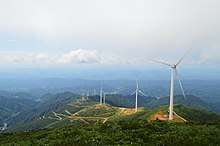
.jpg)
.jpg)



.svg.png)
.svg.png)
